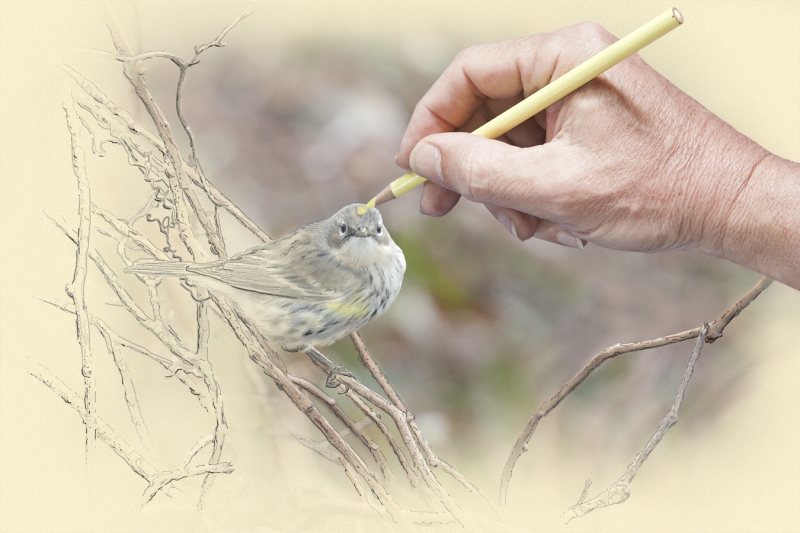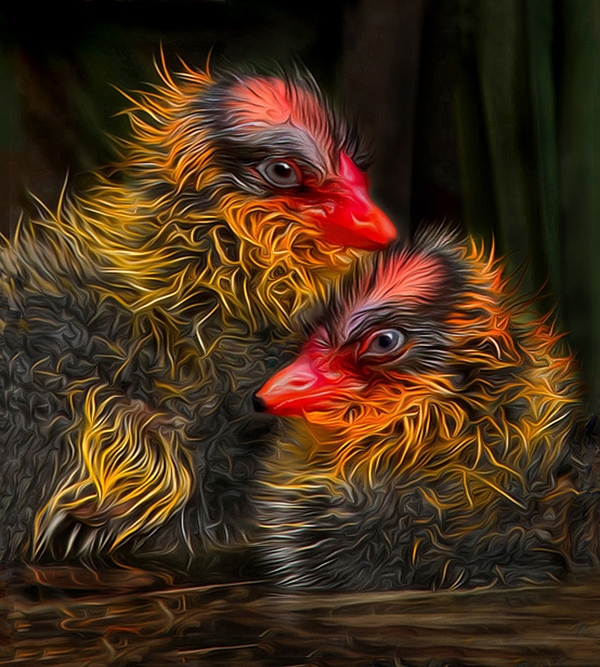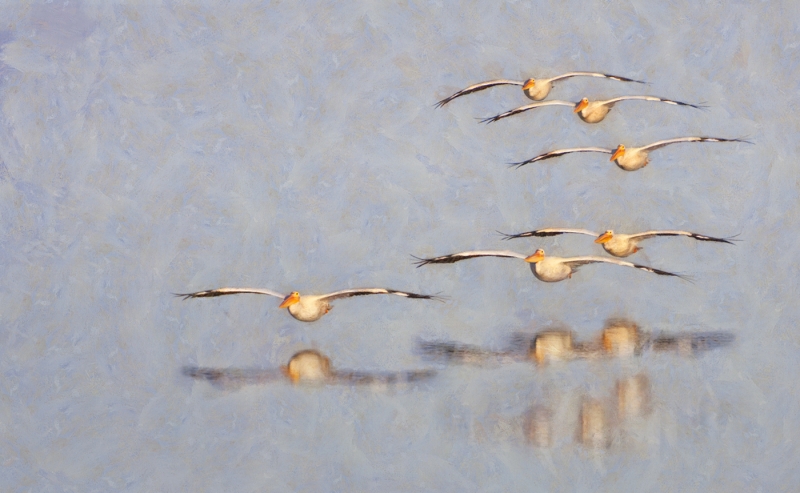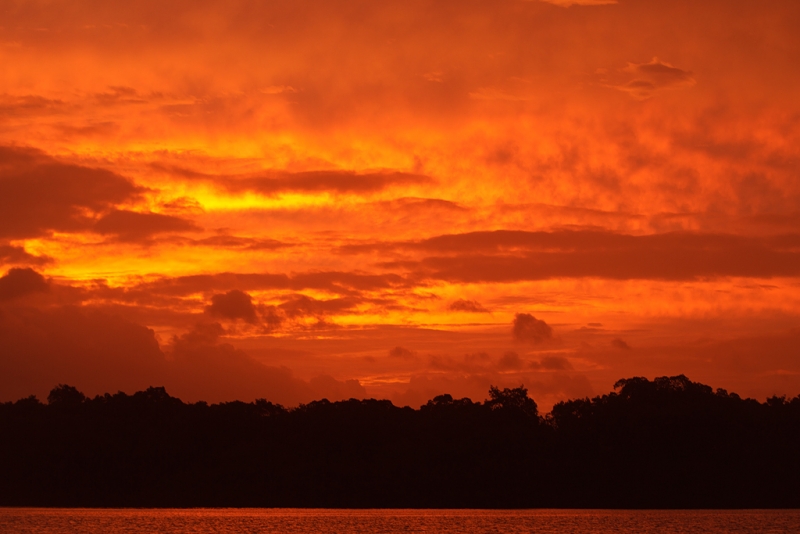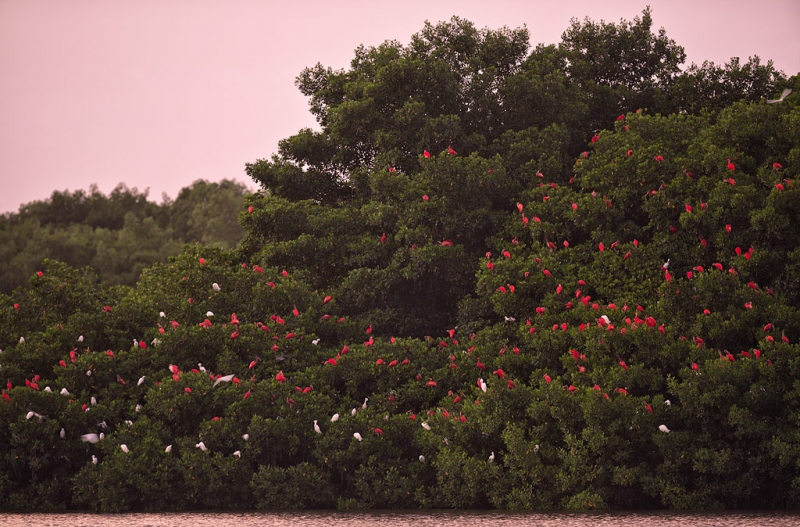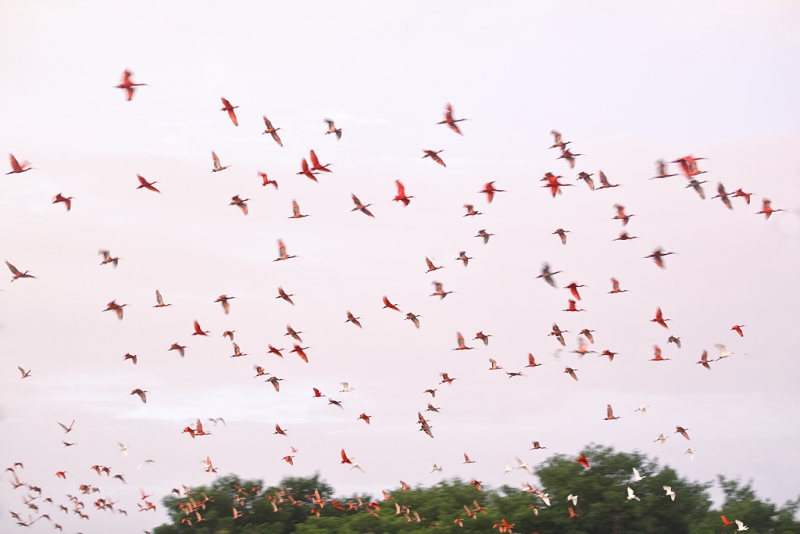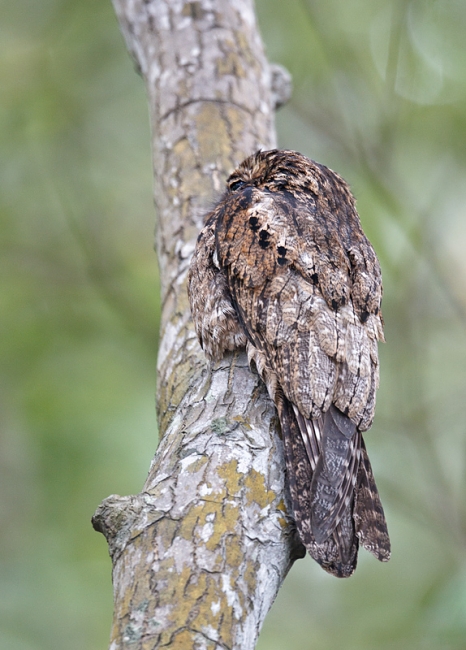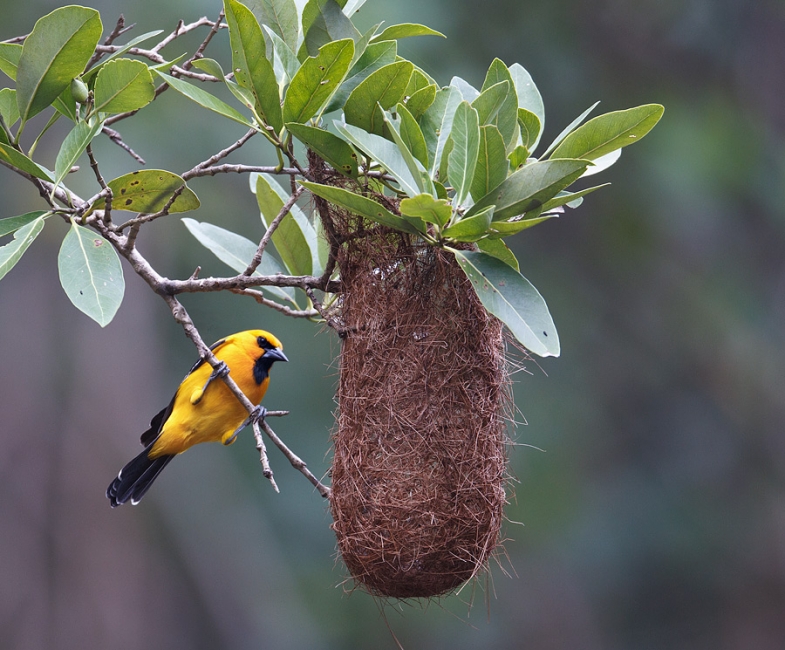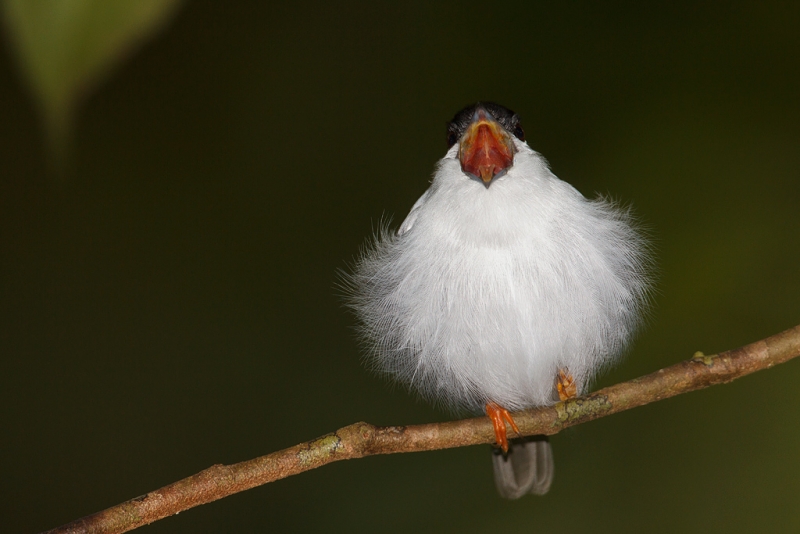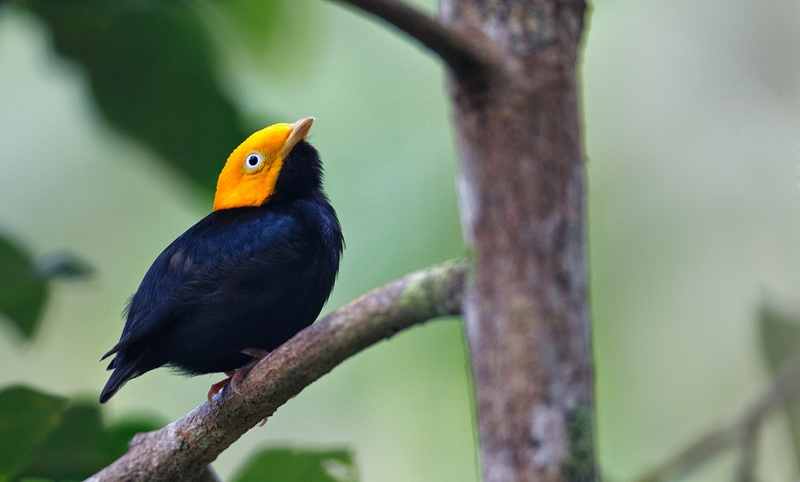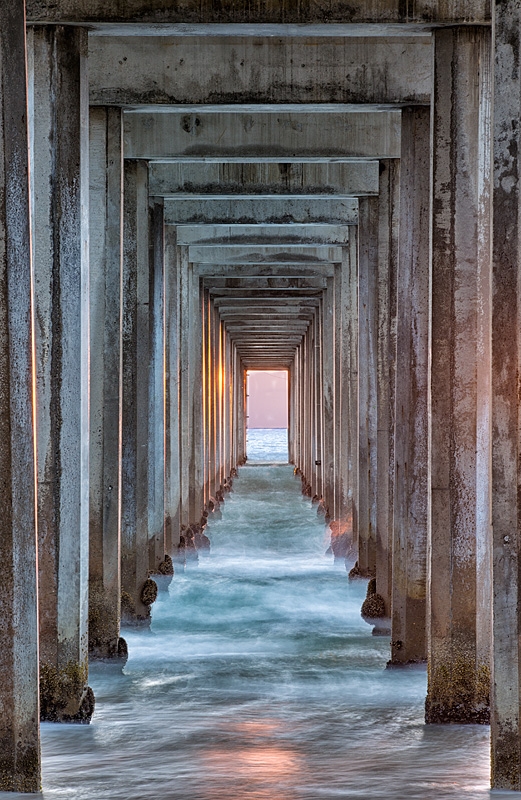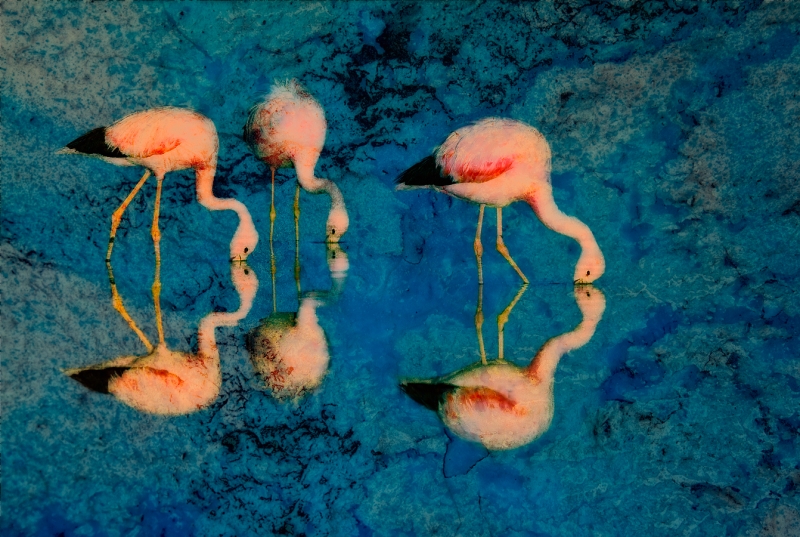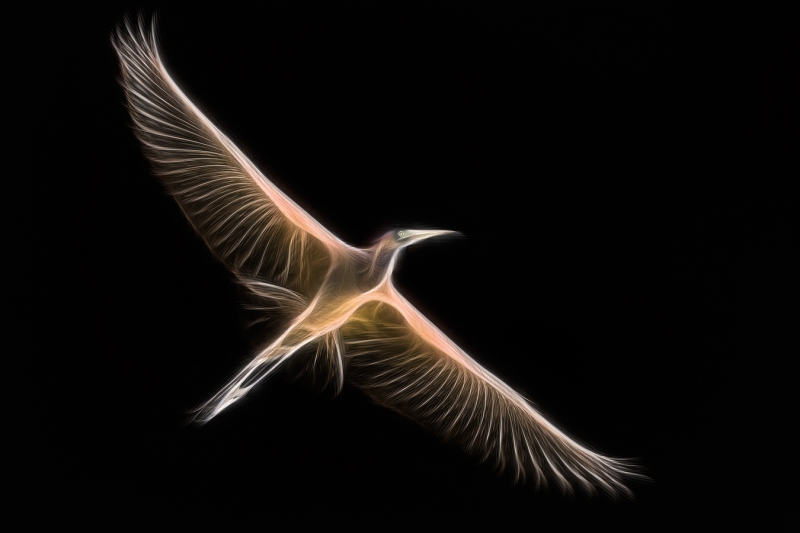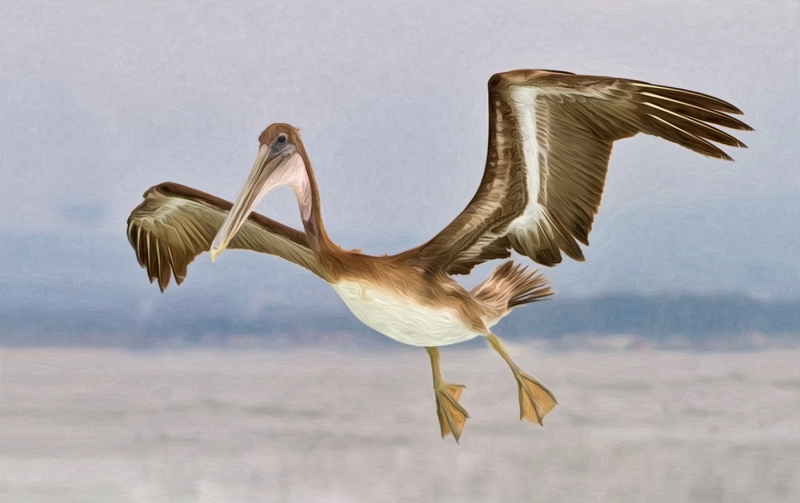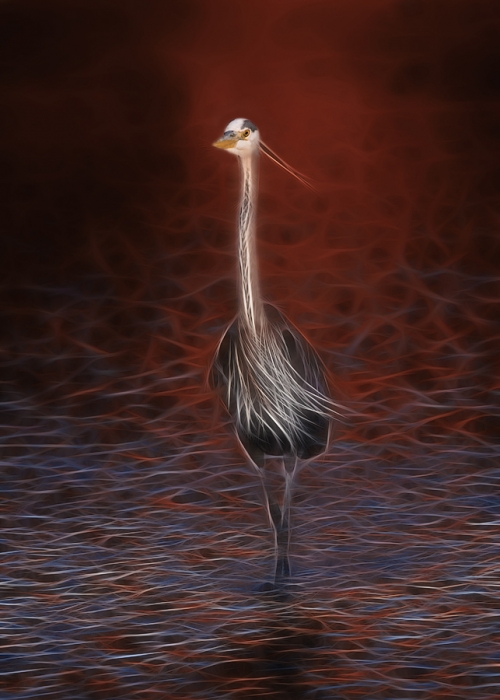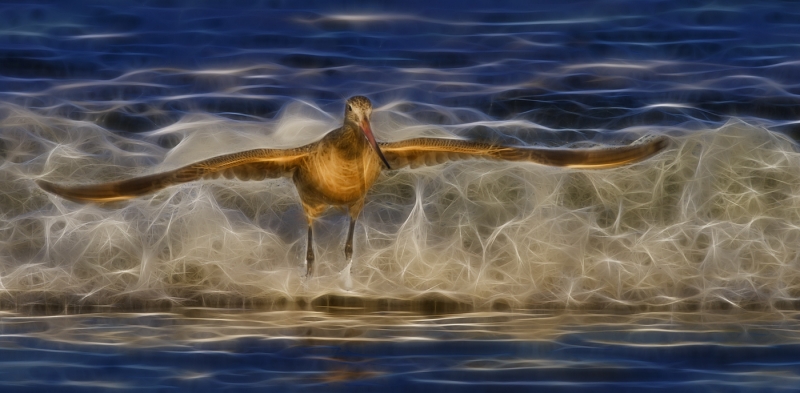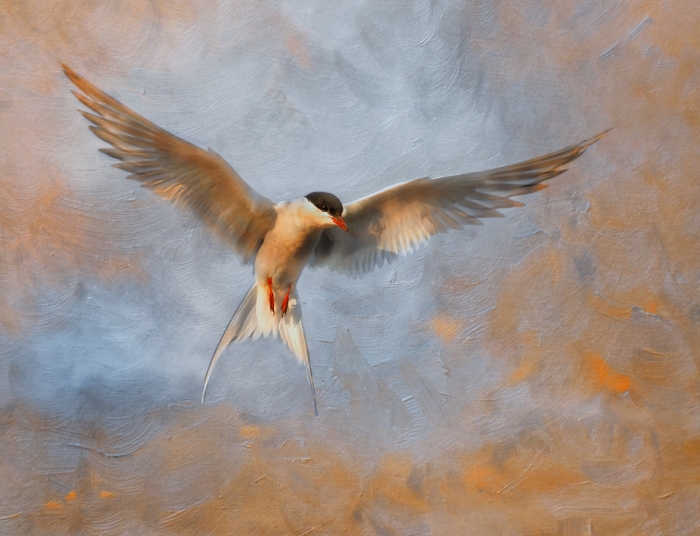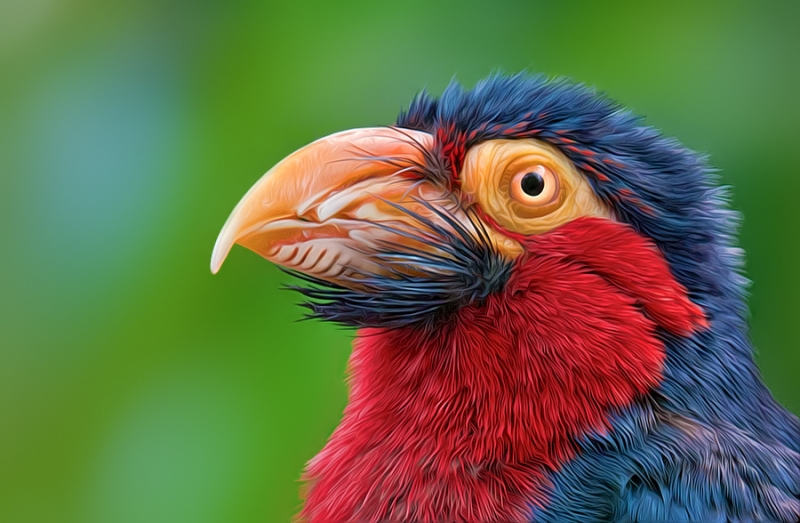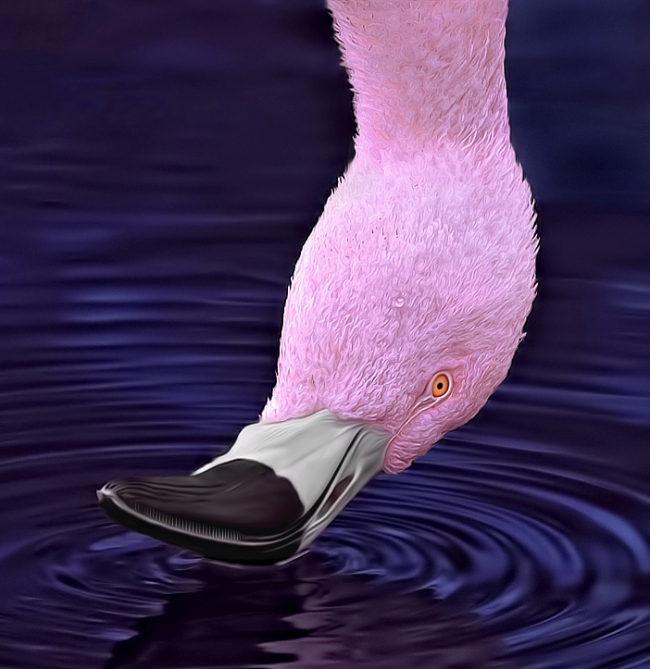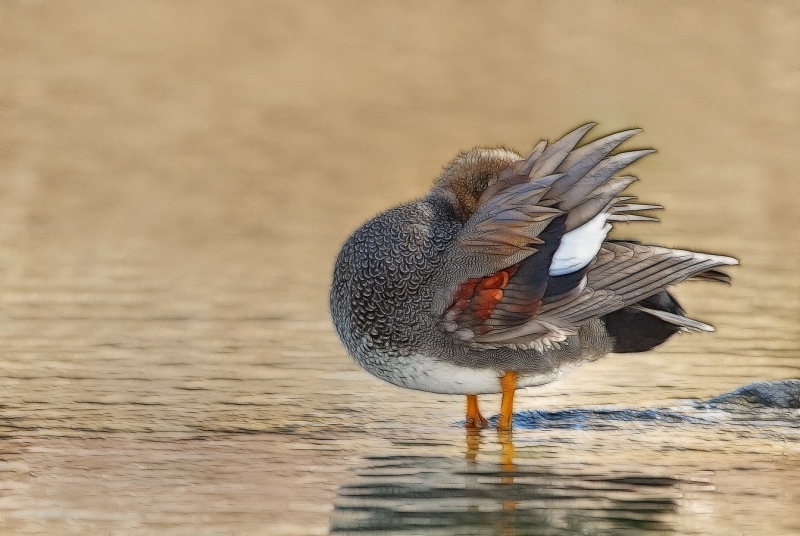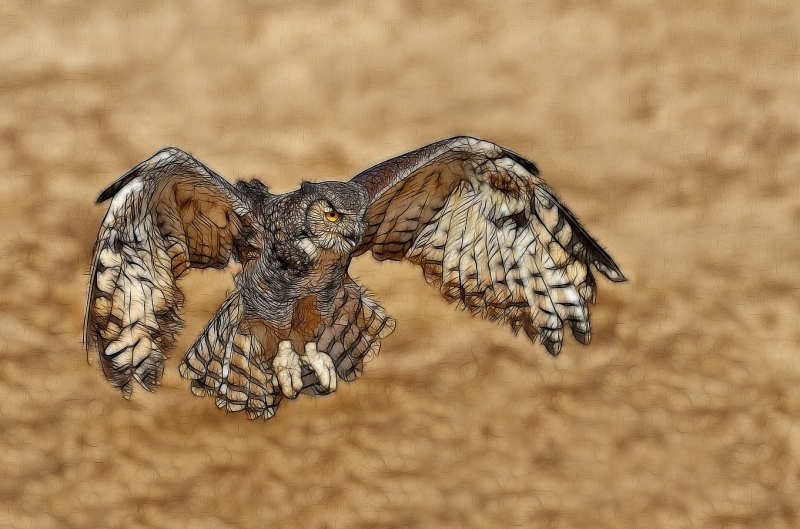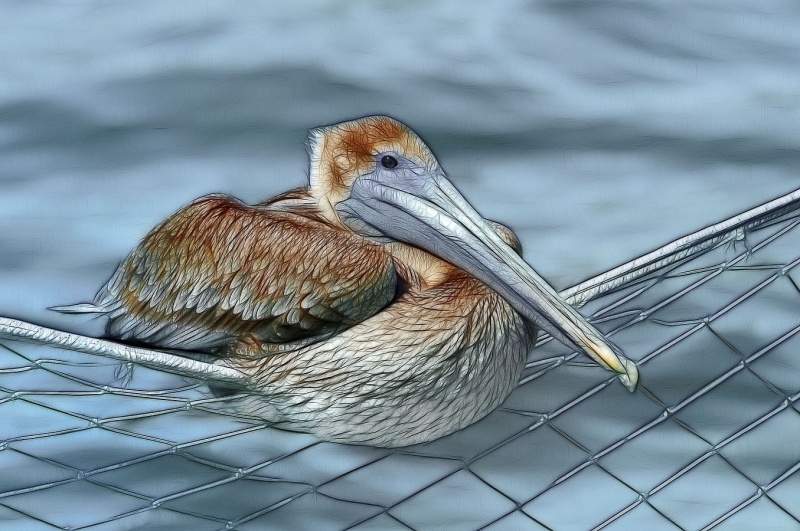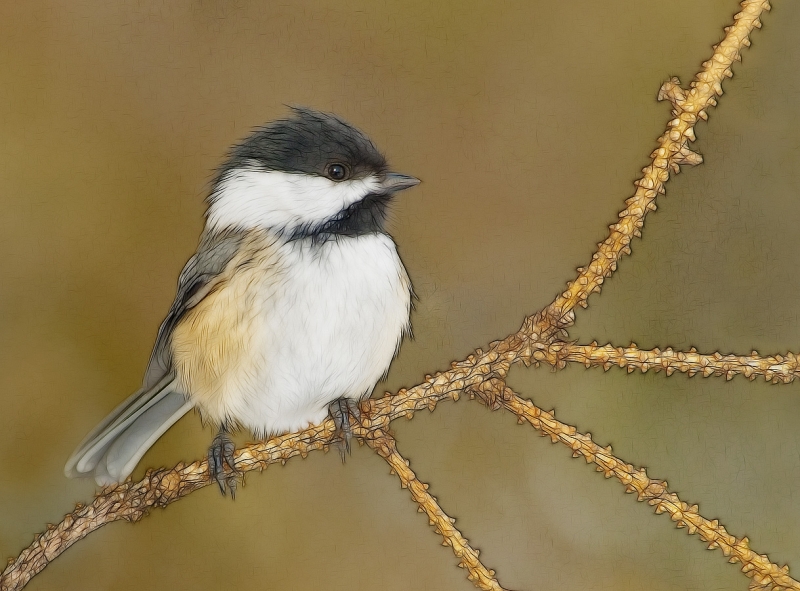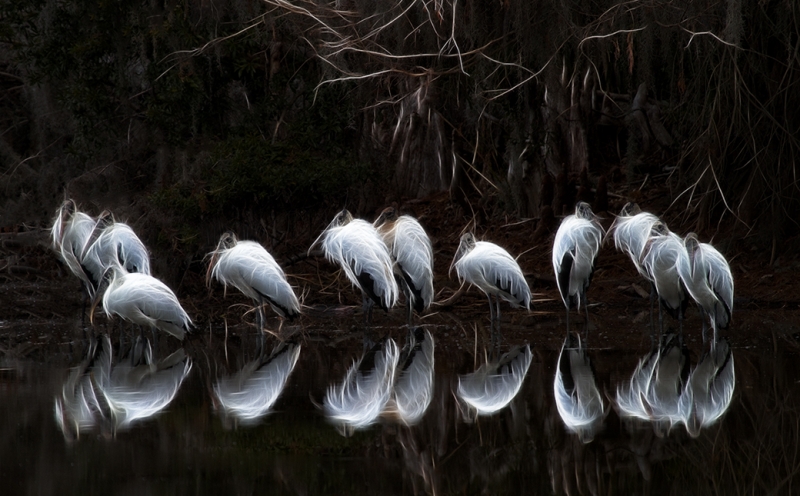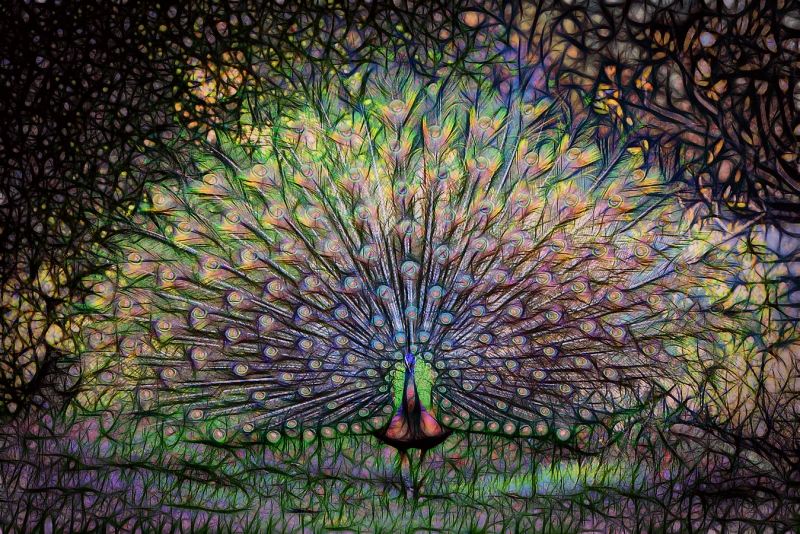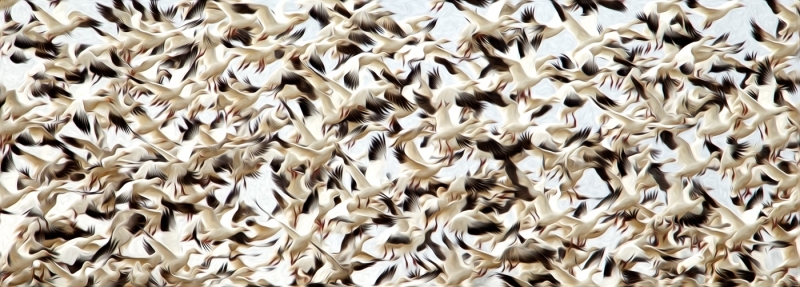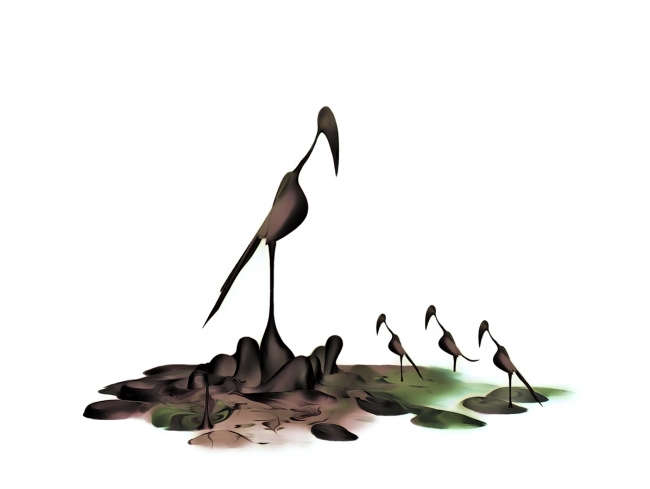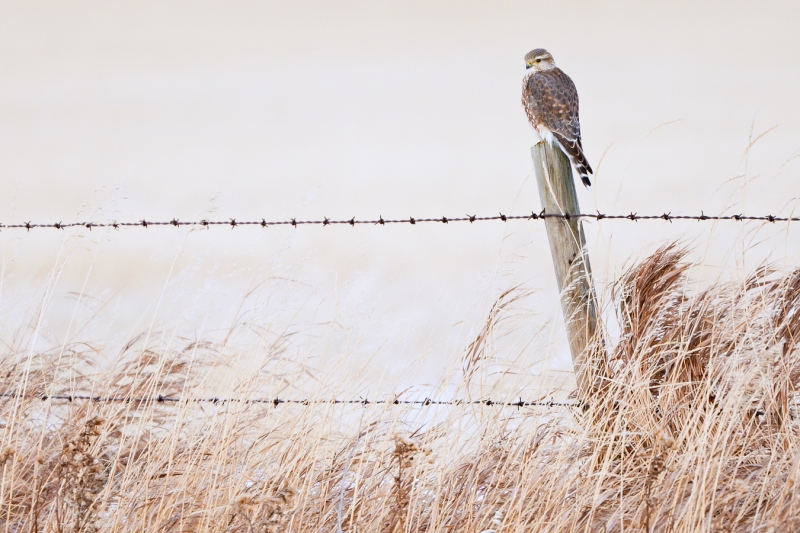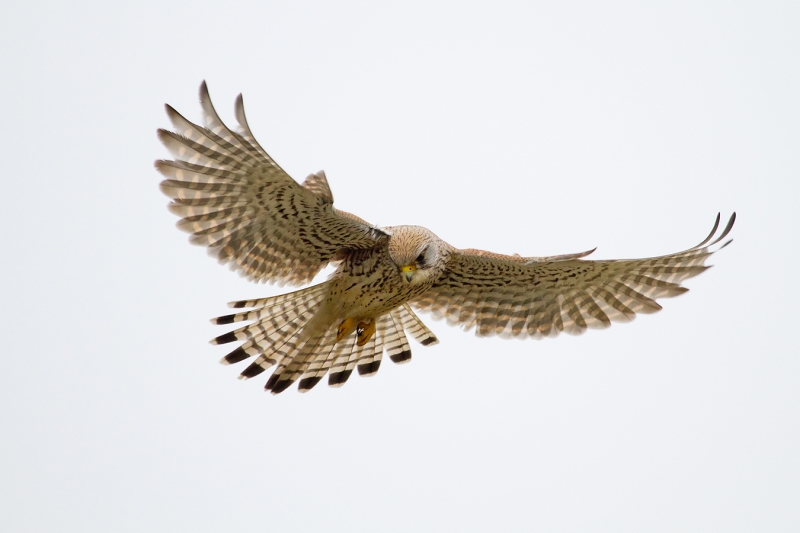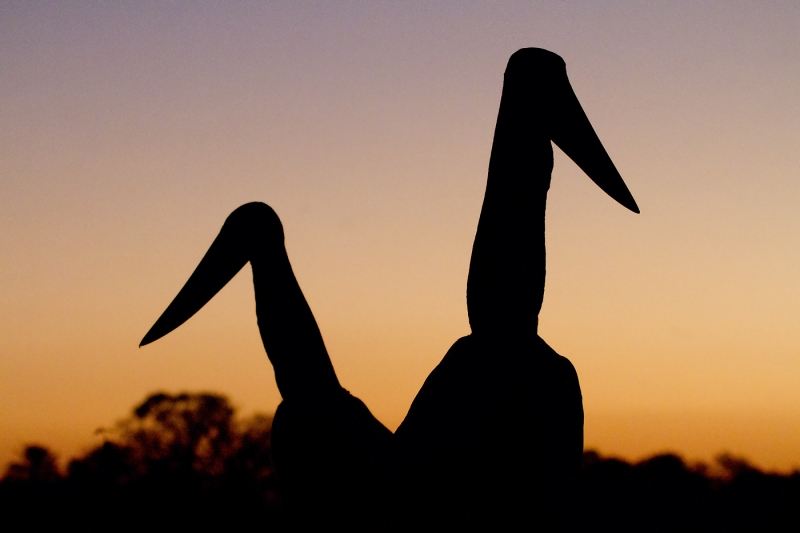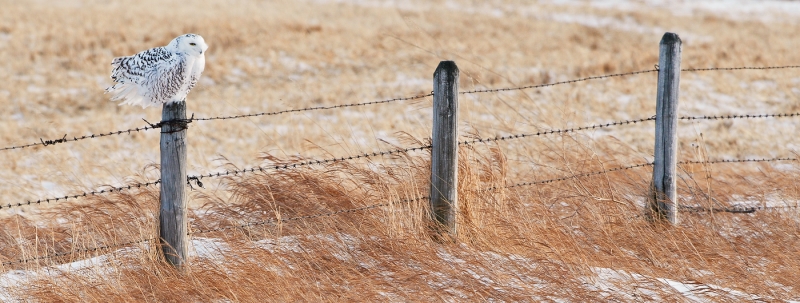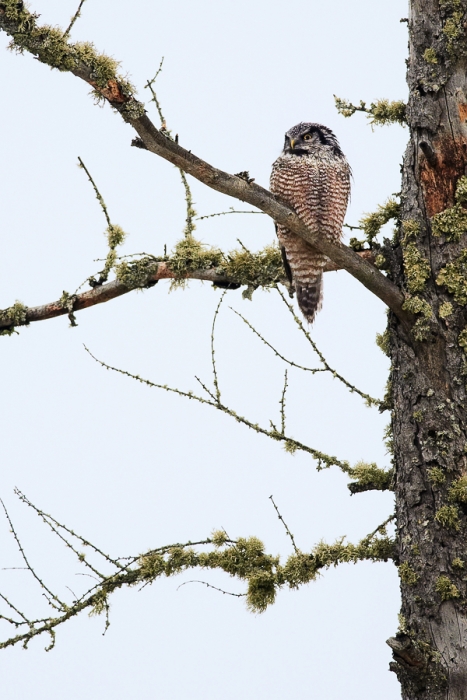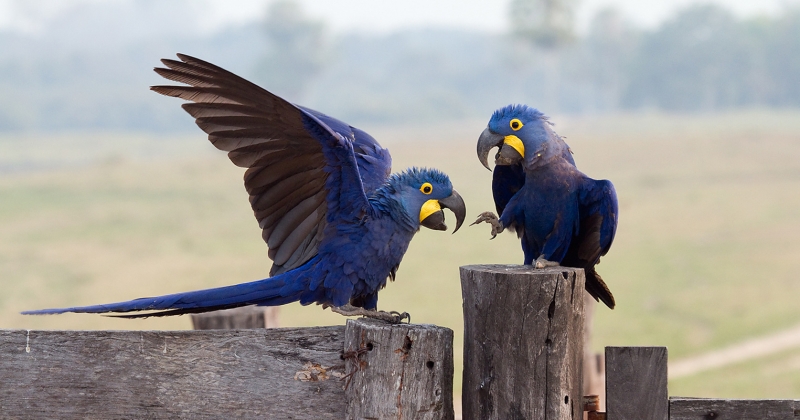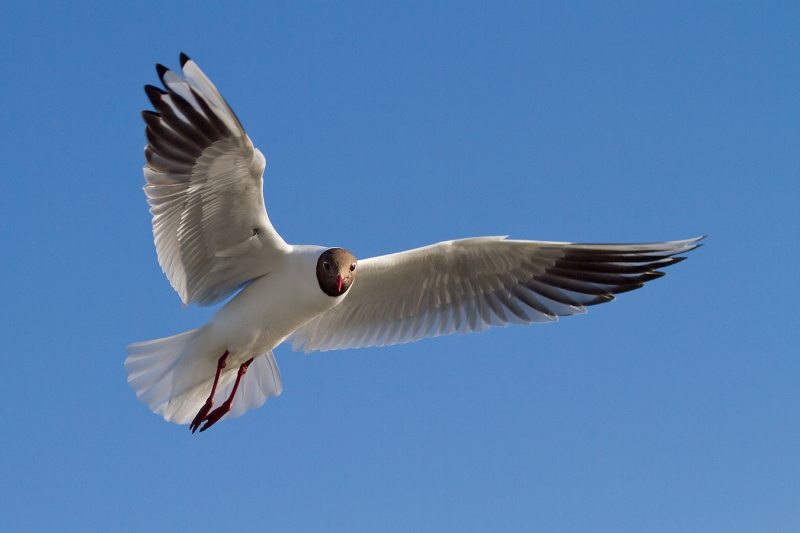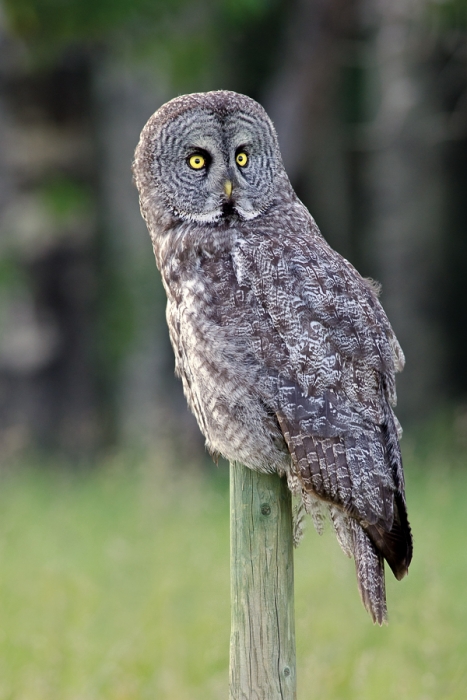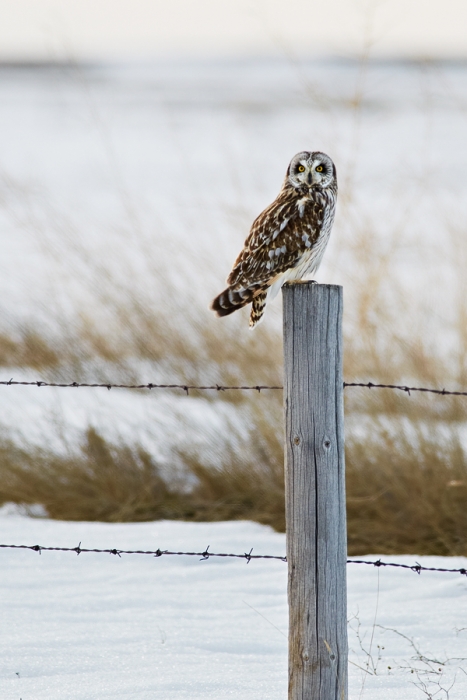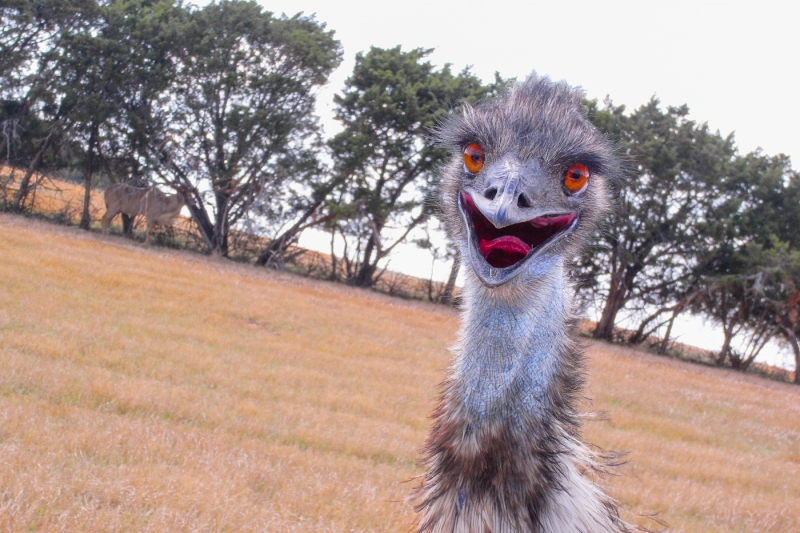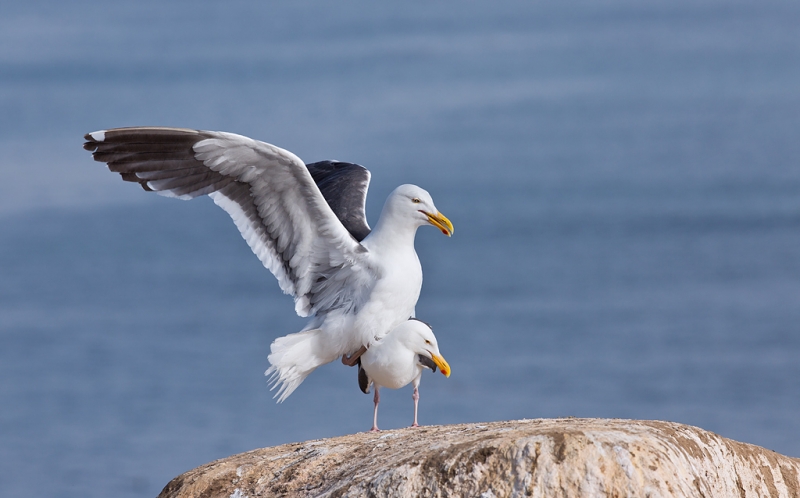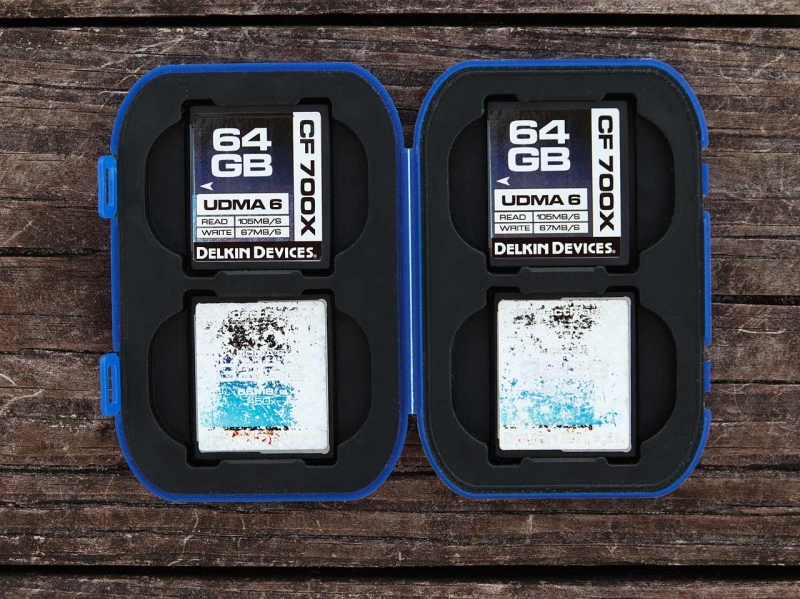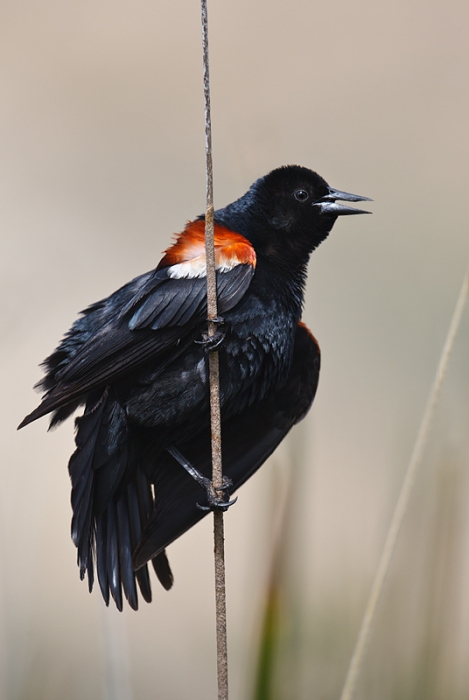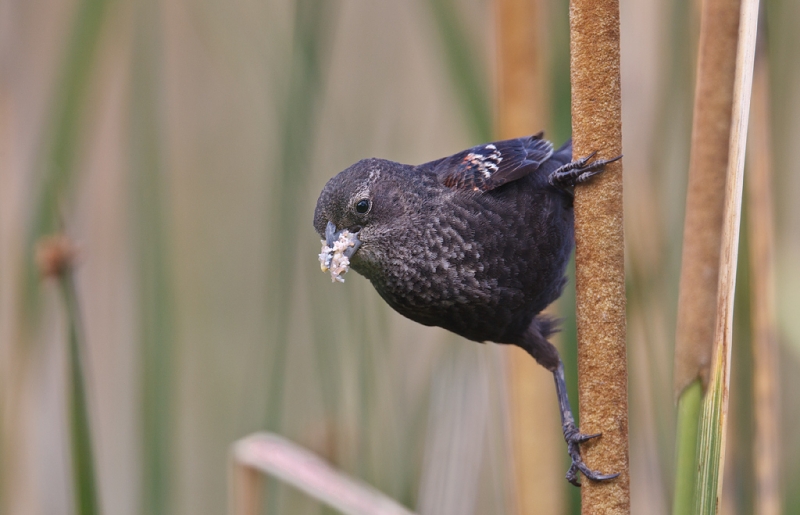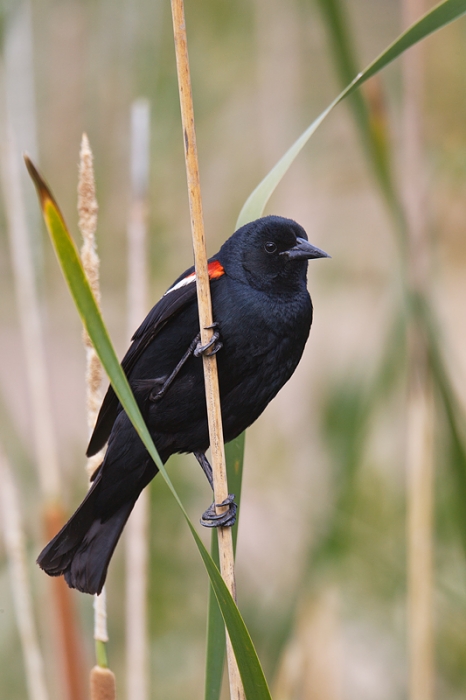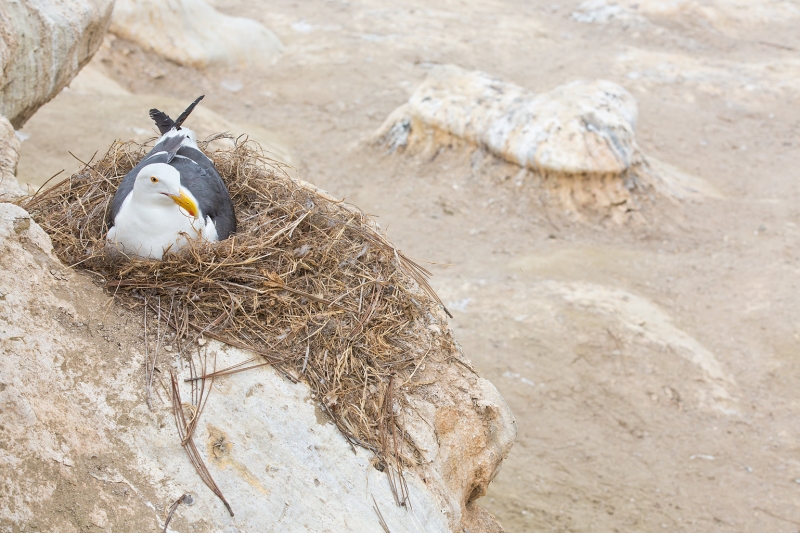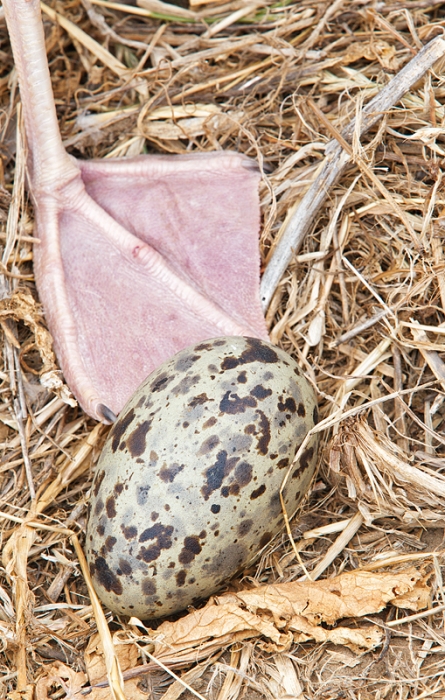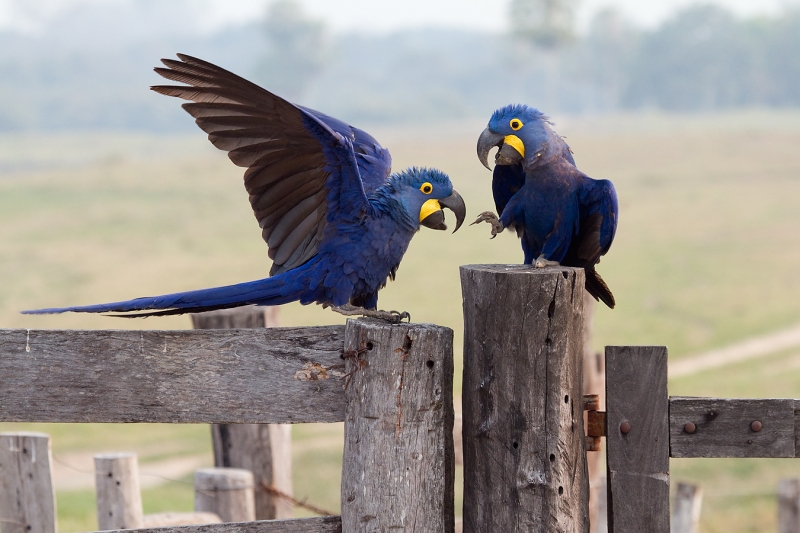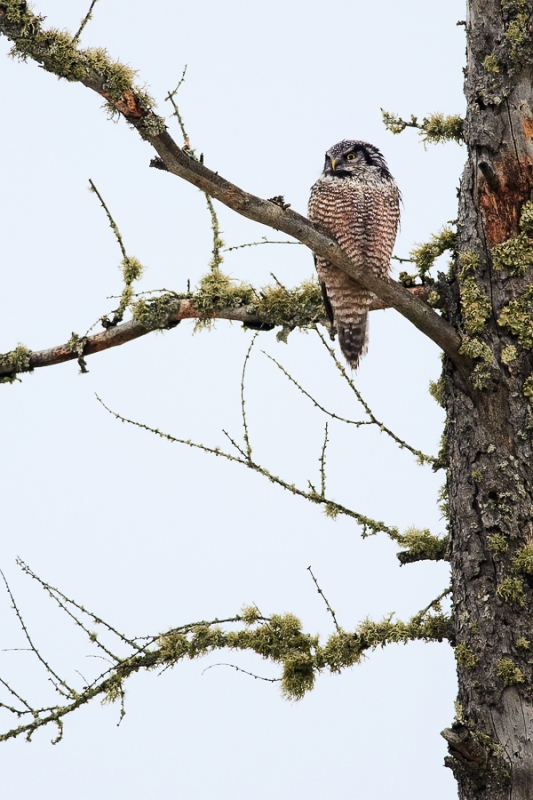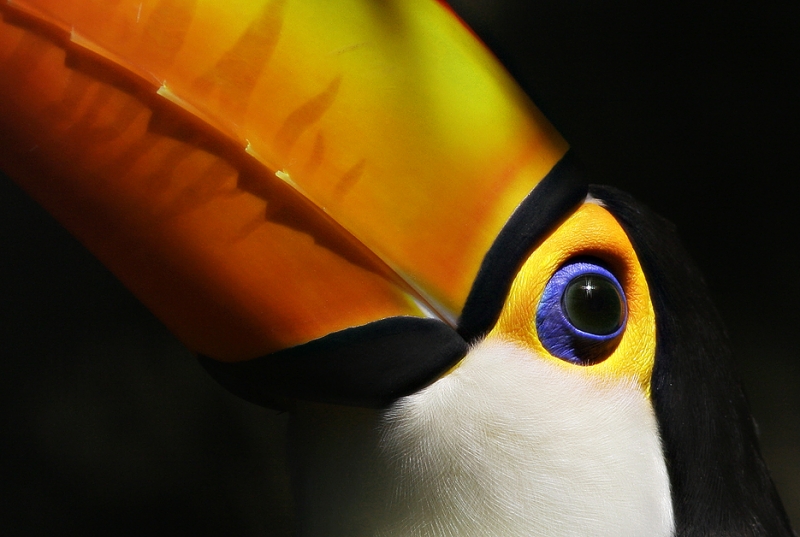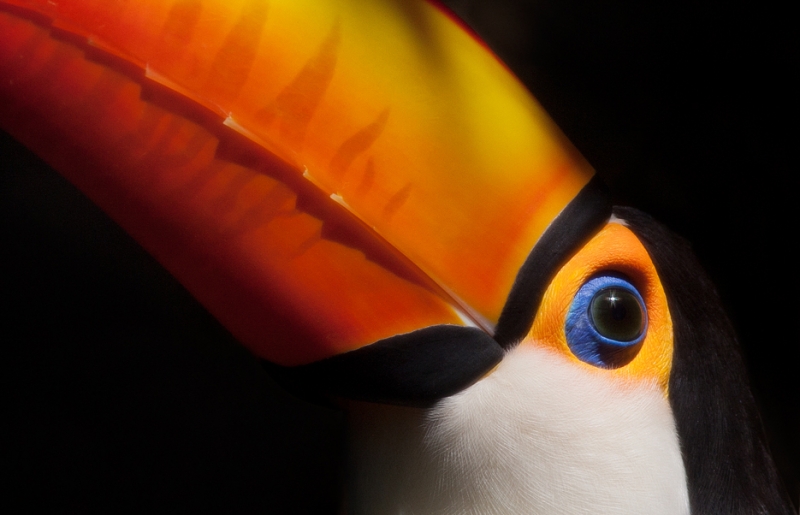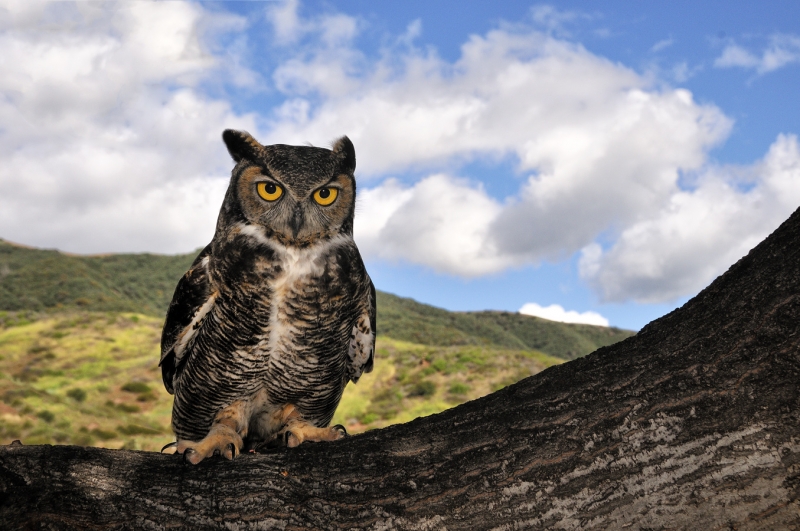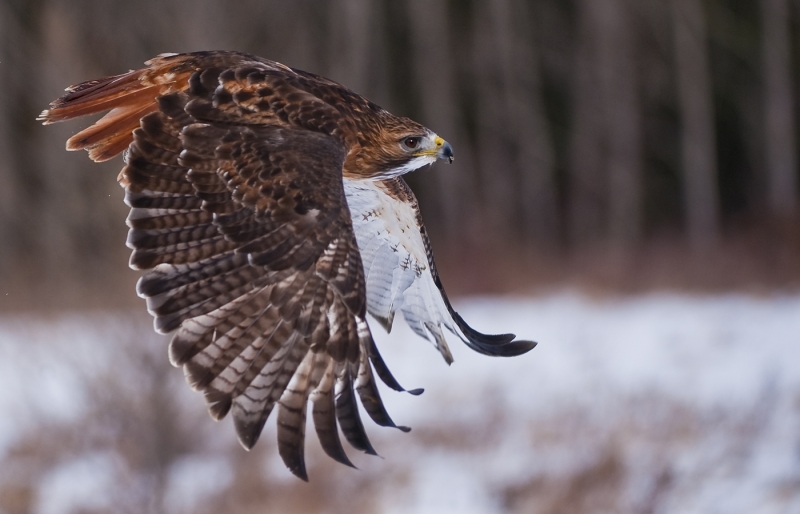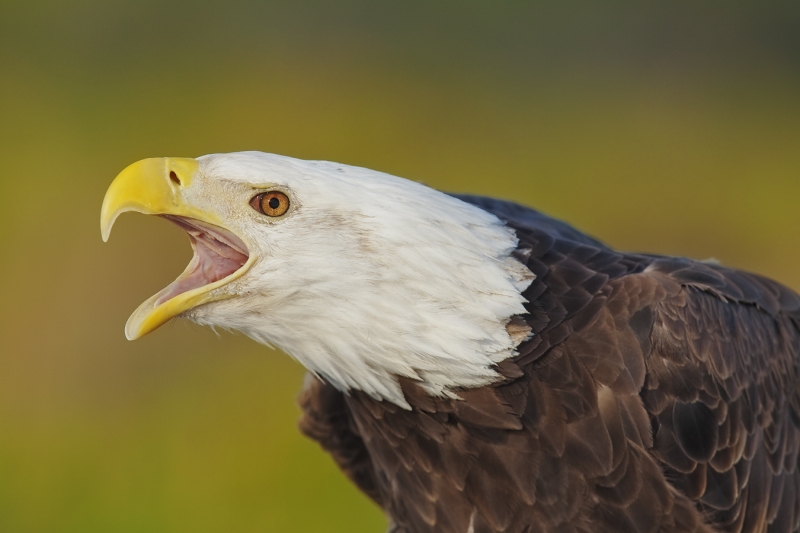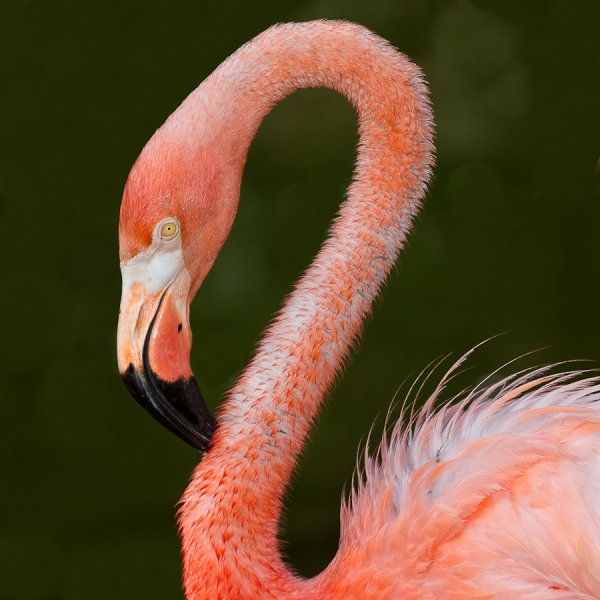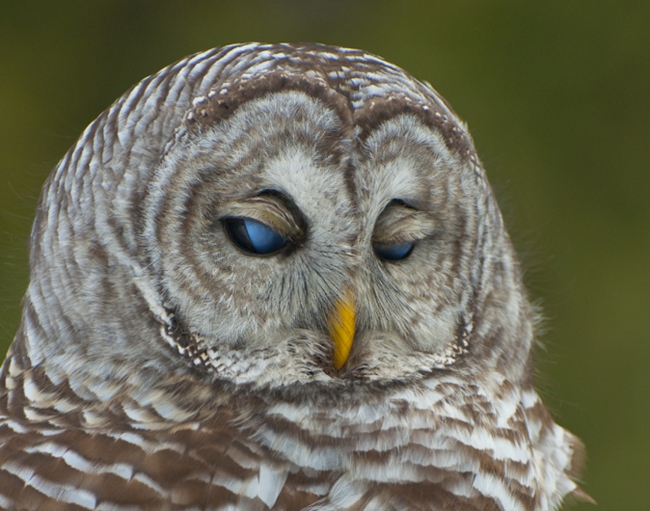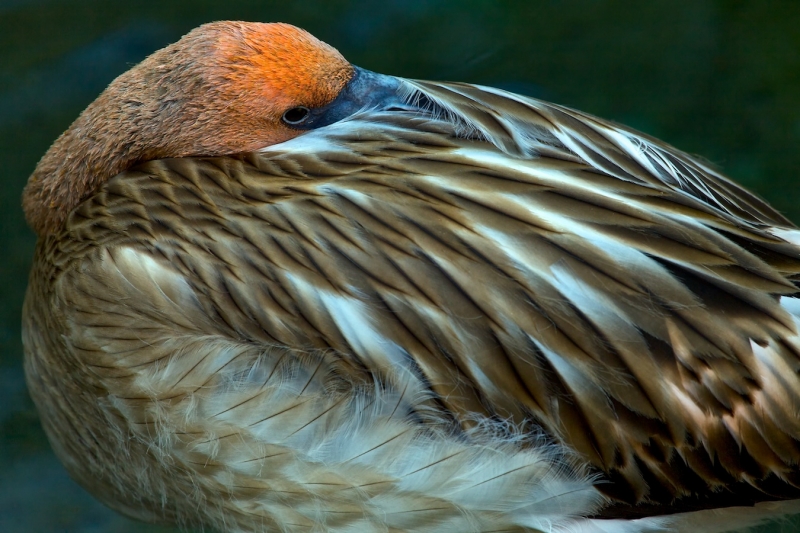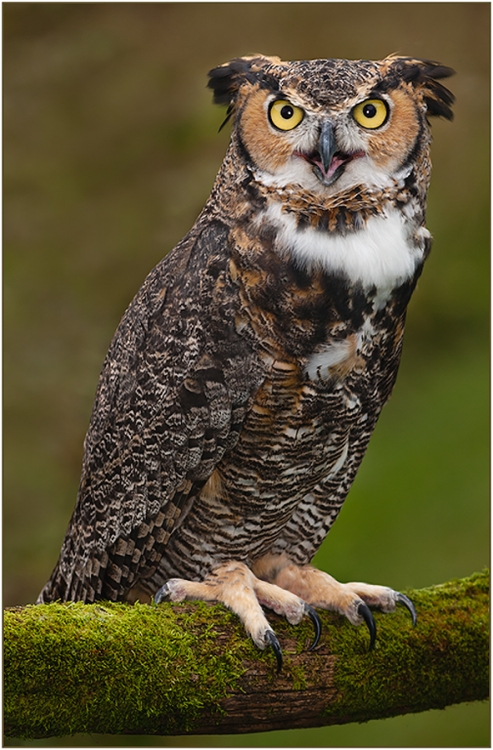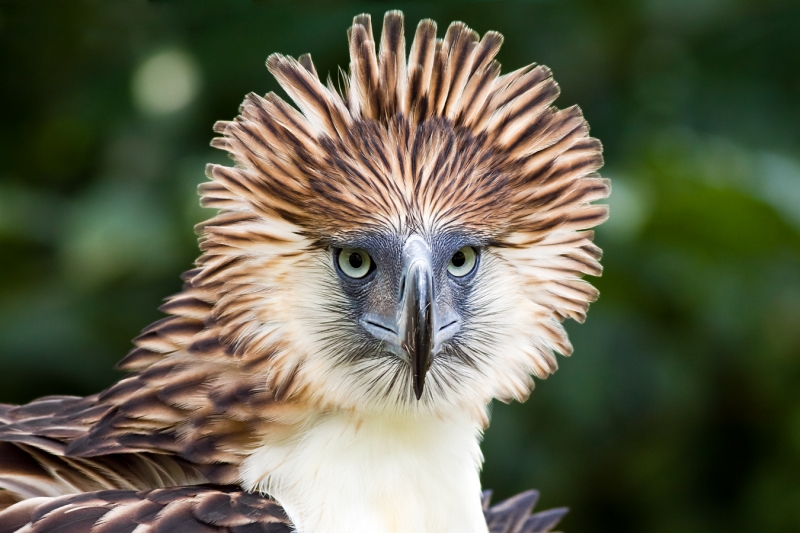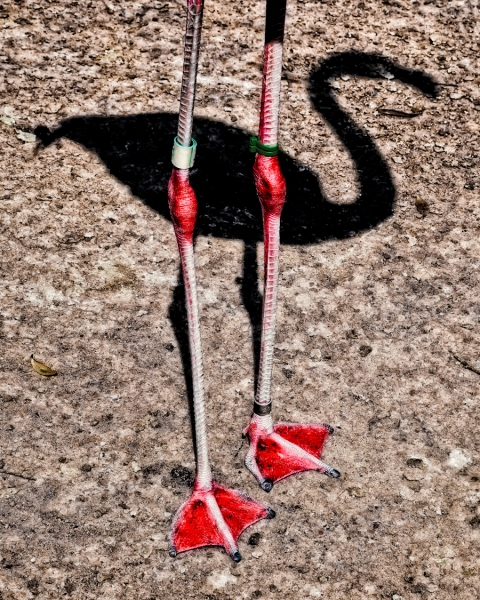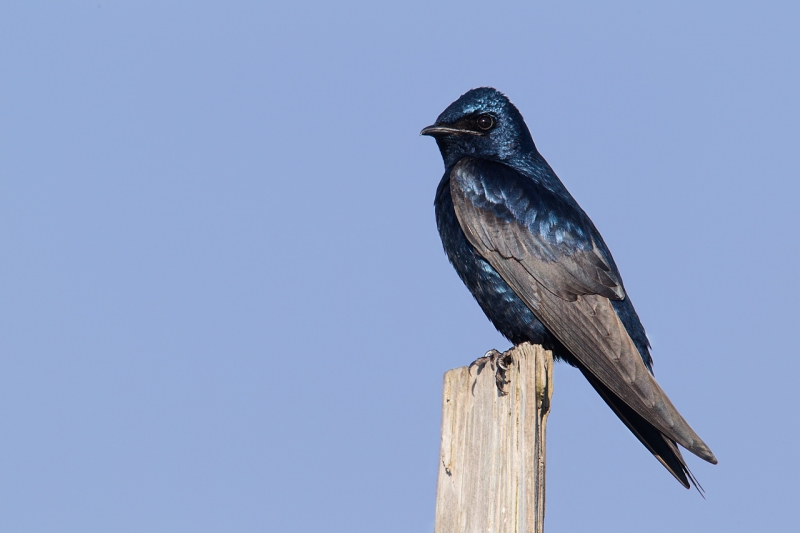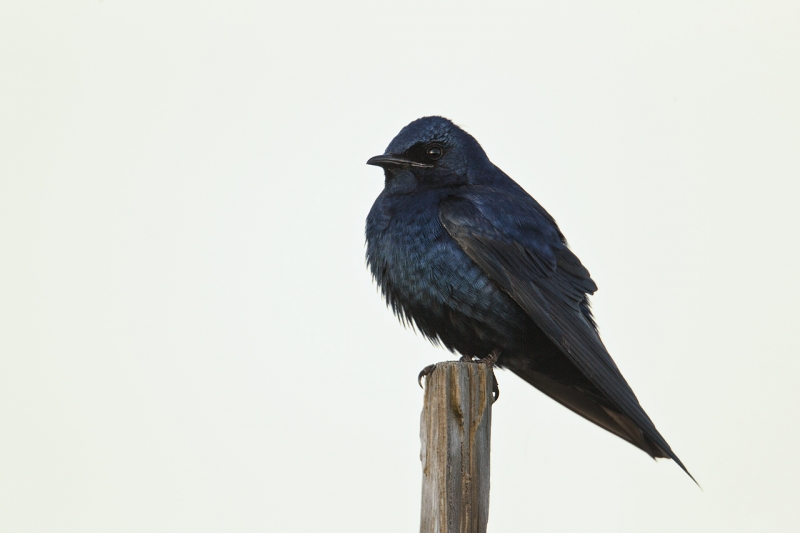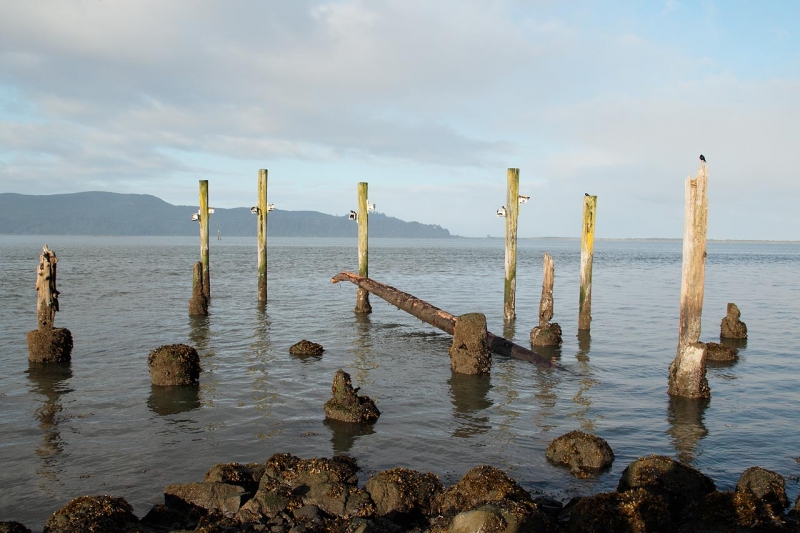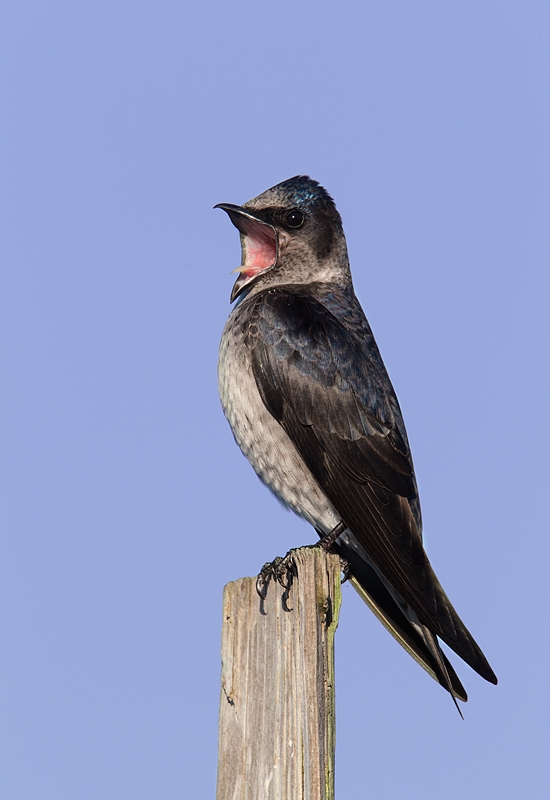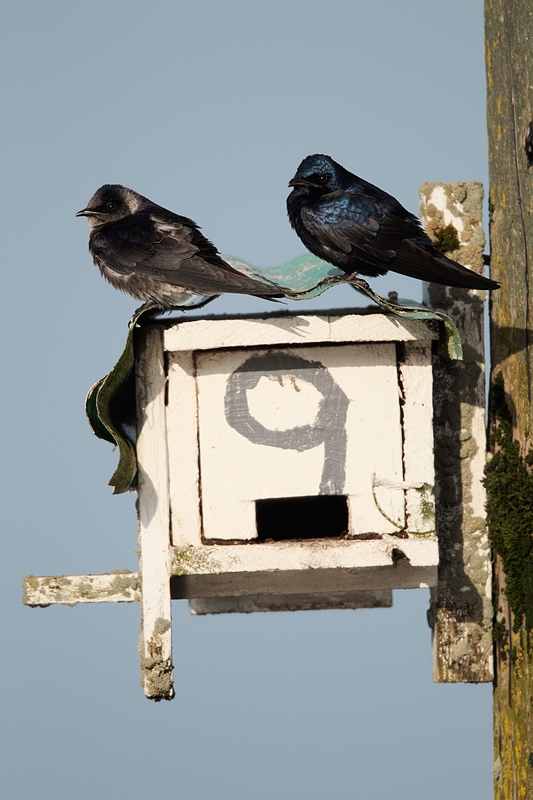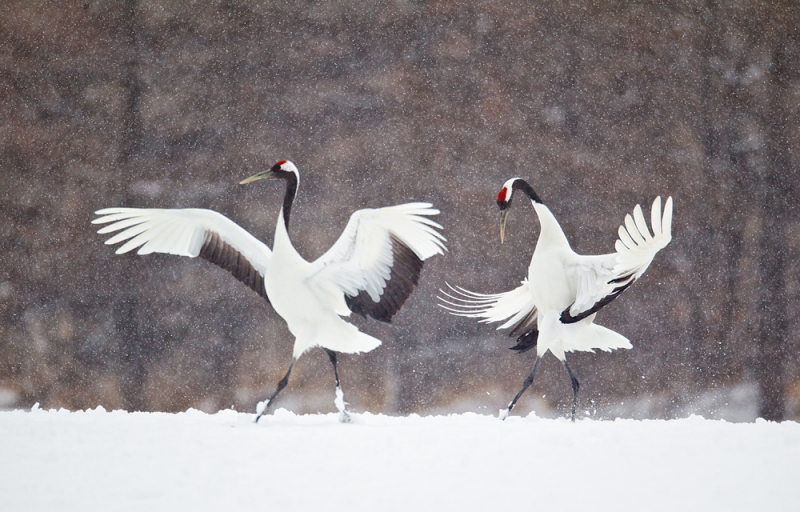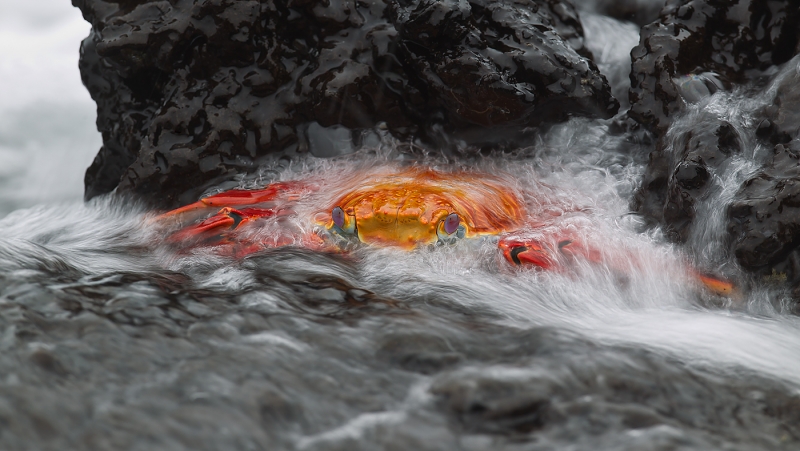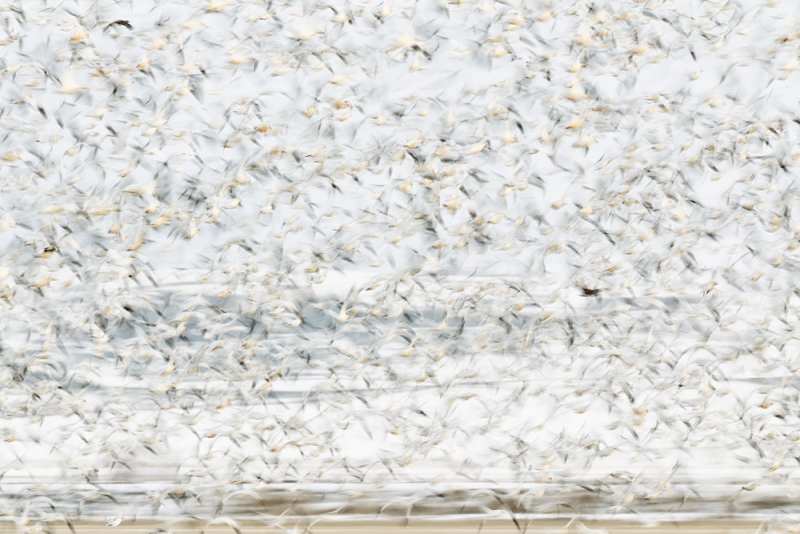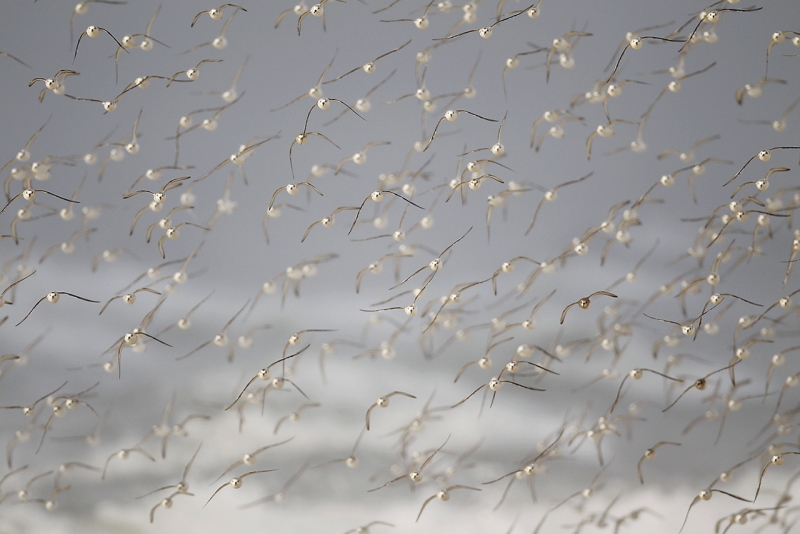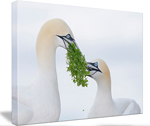June 10th, 2012
|
|
|
Congratulations to Digital Category Winner Jeff Rugg of Montgomery, Illinois, USA (www.greenerview.com). “Yellow-rumped Warbler Art.” The winter plumage yellow-rumped image was created at Pea Island National Wildlife Refuge, North Carolina with a tripod-mounted Canon 100-400 L IS (at 400mm) with the Canon EOS-30D. ISO 400: 1/350 sec. at f/5.6 in Av mode.
|
Yellow-rumped Warbler Art, Jeff Rugg
Jeff’s forethought and creativity in assembling this composite image were indeed remarkable. The soft watercolor look and the various filters that he used added up to our Digital category winner.
From Jeff:
It was a very windy and cold morning as a thunderstorm had gone through at dawn. This normally very active warbler found a protected location out of the wind and sat long enough for me to take several pictures. I liked this one because the bird was looking at me. I created the self-portrait of my own hand in my home against a plain background. I worked with at least 13 layers in Photoshop CS-5 where I did most of the artistic/creative work. I used the new Pencil Tool in a trial version of Photoshop CS-6 for some of the pencil sketch work.
|
|
|
Congratulations to Brendan Dozier. His “Coot Chick Pair Digital Creation” was awarded second prize in the Digital Category in the BIRDS AS ART 1st Annual Bird Photography Competition. The birds were photographed at Guajome Lake, Oceanside, CA with the hand held Canon EF70-200mm f/2.8L IS II USM lens, the 2X II teleconverter, and the Canon EOS-7D. ISO 700: 1/250 sec. at f/14.
|
Coot Chick Pair Digital Creation, Brendan Dozier
The lovely juxtaposition of the too-cute American Coot chicks, two perfect head angles, the bright colors, and the Pixel Bender oil paint effect combined to make this image stand out in a category crowded with creative entries. Brendan took an image created in less than ideal light, added a huge crop and some digital expertise and imagination to create something special. (Note: as far as the huge crop, anything goes in our Digital Category.)
From Brendan:
I had never seen coot chicks before and was thrilled to be able to capture these adorable little ones at a local lake. Loved their wild feathers and bright coloring. Moving slowly I got as close to the waters edge as I could and lay down on my side. Unfortunately the chicks did not venture out of the reeds until late morning so the light was a bit harsh. I was wishing that I had a bit longer lens. Not having the best image quality after a large crop, I decided that the original image would be a good candidate for an artistic filtering treatment as I really wanted to highlight those crazy feathers and colors. So I did some levels and color adjustments in CS5, darkened and cloned out a few areas in background and foreground, and applied Pixel Bender filter “oil” setting from Adobe Labs. Some touching up of eyes and sharpening resulted in the finished image.
|
|
|
Congrats to Indranil Sircar. His “White Pelican Squadron” creation was awarded third place in the Digital category. He photographed the small flock of 6 American White Pelicans at Don Edwards NWR, Milpitas, CA with the Sigma 50-500mm lens (on the Mongoose M3.5) and the Canon EOS-40D. ISO 400: 1/2000 sec. at f/8.
|
White Pelican Squadron, Indranil Sircar
The musical arrangement of the subjects, the soft light, the lovely choice of a complementary background texture, enough depth of field to cover all the birds, and the subtle reflections are the strengths of this image.
From Indranil:
I created the base image of these Pelicans flying in formation early one morning when the water was calm. The pelicans where flying low and I tracked them as they approached to land on a small island in one of the salt ponds. For a brief moment there was separation among all the pelicans and I got my image! I cropped the image slightly and removed a tide line and some spots of debris in the background. I enhanced the in Dynamic Auto Painter (DAP) and then tweaked it in Photoshop using multiple layers. I reduced the opacity of the painted layer to about 30% to bring out more of the original image and then used a layer mask and painted over the pelicans to further reveal the original image.
Of Note
Not surprisingly two of the three honored photographers in the Digital Creations category–Brendan and Indranil–are regulars in the Out-of-the-Box forum at BirdPhotographers.Net where Indranil is one of three Moderators led by Denise Ippolito who has been doing yeoman work there for more than two years.
On Grammar…
Brendan originally e-mailed: “….moving slowly, and laid down on my side.”
I am as confused as anyone on the correct usage of lay and lie so I did an online search and come wound here at the Oxford Dictonary. “Lie or lay? Laying down the law on some puzzling verbs” is the finest treatment of the subject that I have come across. I have book-marked it.
Congrats!
Congrats to all who placed images in the top ten in the Digital Creations category. It was a very popular category with 301 images making the first cut. You can see the nineteen images that were sent to the judges here. Getting to the final round is quite an accomplishment. Prizes (see below) will be shipped once all the winners are announced as several folks had more than one top three images. Be sure to patronize our sponsors; without them, this contest would not exist. There will be more educational stuff from this category coming soon.
June 8th, 2012 Caroni Swamp Adventure
The alarm was set for 2:50am. By 3:35 we were in the vans headed for the dock. By 4:30am, Lester, our boatman, guided us through the narrow canals spotting snakes and nightjars in the blackness with a powerful spotlight. The plastic bags came out as a brief squall passed. Well before dawn Lester had positioned the boat square to a reddening eastern sky.
|
|
|
This image was created with the Canon 70-200mm f/2.8L IS II lens(hand held at 85mm) and the Canon EOS-5D Mark III. ISO 200. Evaluative metering at zero: 1/15 sec. at f/3.5 in Tv mode. I was set up for blast off blurs but figured I could make a sharp image at 1/5 by using good sharpness technique with such a short focal length.
Central Sensor/AI Servo Rear Focus AF active at the moment of exposure. Click here if you missed the Rear Focus Tutorial. Click on the image to enjoy a larger version.
|
As light levels increased we could see hundreds of Scarlet Ibises on their red mangrove roost island looking like a scattering of rubies on green felt.
|
|
|
This image was created with the hand held Canon 300mm f/2.8 L IS II lens and the Canon EOS-5D Mark III. ISO 800. Evaluative metering -2/3 stop: 1/30 sec. at f/2.8 in Manual mode. Again, it was imperative to use my very best sharpness techniques in order to create a sharp image, this time at 1/30 sec. with the 300mm. Four-stop IS helps too!
Right Hand (Surround)Sensor/Surround/AI Servo Rear Focus active at the moment of exposure. Click here if you missed the Rear Focus Tutorial. Click on the image to enjoy a larger version.
|
When they blasted off, most of us were a bit unprepared….
|
|
|
This image was created with the Canon 70-200mm f/2.8L IS II lens(hand held at 102mm) and the Canon EOS-5D Mark III. ISO 1600. Evaluative metering +2 2/3 stops: 1/60 sec. at f/2.8 in Tv mode. At the very least I should have been at 1/30 sec. with auto ISO; that would have put me at 1/30 sec. at ISO 800….
Central Sensor/AI Servo Rear Focus AF active at the moment of exposure. Click here if you missed the Rear Focus Tutorial. Click on the image to enjoy a larger version.
|
We spent the next few hours cruising the canals for wildlife. Lester was quite skilled at spotting well-camouflaged Common Potoo and Cook’s Tree Boa.
|
|
|
This Common Potoo was photographed with the tripod-mounted Canon 800mm f/5.L IS lens and the Canon EOS-1D Mark IV. ISO 800. Evaluative metering +2/3 stop: 1/25 sec. at f/5.6 in Av mode. Yes. You read that correct. 1/25 second. You gotta love 4-stop IS.
Right of center sensor AI Servo/Rear Focus AF active at the moment of exposure. Click here if you missed the Rear Focus Tutorial. Click on the image for a larger version.
|
When we all spotted a Yellow Oriole entering its nest we backed the boat off, tied up to a tree, and waited patiently. It turned out to be our best photographic opportunity but for the ibises. Between the potoo and the oriole we enjoyed an amazingly sumptuous and delicious breakfast of salted cod fish salad, hard-boiled egg, hot ratatouille and eggplant melange. With coffee and tea. All served on real china with fine silverware thanks to the great staff at Asa Wright Nature Center.
|
|
|
This Yellow Oriole at the nest was photographed with the tripod-mounted Canon 800mm f/5.L IS lens and the Canon EOS-1D Mark IV. ISO 800. Evaluative metering +1/3 stop: 1/250 sec. at f/5.6 in Av mode.
Left side (Surround) sensor AI Servo/Rear Focus AF and recompose. Click here if you missed the Rear Focus Tutorial. Click on the image for a larger version.
|
After three great days in Trinidad we are off for Tobago and Red-tailed Tropicbirds.
Shopper’s Guide
Below is a list of the gear used to create the images in today’s post. Thanks a stack to all who have used the Shopper’s Guide links to purchase their gear as a thank you for all the free information that we bring you on the Blog and in the Bulletins. Before you purchase anything be sure to check out the advice in our Shopper’s Guide.
Canon 70-200mm f/2.8L IS II lens. Man, I am loving this lens on my shoulder with the 2XIII teleconverter. I also use it a lot–depending on the situation–with the 1.4X III TC.
Canon 300mm f/2.8 L IS II lensI finally broke down and purchased my own copy of this great flight photography and general purpose lens.
Canon 800mm f/5.6L IS lens. Right now this is my all time favorite super-telephoto lens.
Canon EOS-5D Mark III. Man, I am in love with this camera body. Both the files and the AF system are superb.
And from the BAA On-line Store:
LensCoats. I have a LensCoat on each of my big lenses to protect them from nicks and thus increase their re-sales value. All my big lens LensCoat stuff is in Hardwood Snow pattern.
LegCoat Tripod Leg Covers. I have four tripods active and each has a Hardwood Snow LegCoat on it to help prevent further damage to my tender shoulders 🙂 And you will love them in mega-cold weather….
Gizo GT3532 LS CF Tripod. This one replaces the GT3530LS Tripod and will last you a lifetime. I’ll be commenting on this new model soon. In short, I like it.
Mongoose M3.6 Tripod Head. Right now this is the best tripod head around for use with lenses that weigh less than 9 pounds. For heavier lenses, check out the Wimberley V2 head.
Double Bubble Level. You will find one in my camera’s hot shoe whenever I am not using flash.
The Lens Align Mark II. I use the Lens Align Mark II pretty much religiously to micro-adjust all of my gear an average of once a month and always before a major trip. Enjoy our free comprehensive tutorial here.
BreezeBrowser. I do not see how any digital photographer can exist without this program.
June 6th, 2012
|
|
|
This fluffed up male White-bearded Manakin was photographed with the tripod-mounted Canon 800mm f/5.L IS lens, the 1.4X III TC, and the Canon EOS-1D Mark IV. ISO 800. Evaluative metering at -1/3 stop: 1/50 sec. at f/10 in Manual mode. Quasi-flash as main light at -2/3 stop with the Canon Speedlite 600EX-RT with the Better Beamer.
Central sensor (by necessity) AI Servo/Rear Focus AF and recompose. Click here if you missed the Rear Focus Tutorial. Click on the image for a larger version.
|
Trinidadian Gems
On our first walk at the Asa Wright Nature Center in Trinidad Denise Ippolito and I have the pleasure of visiting the leks (dancing areas) of both White-bearded and Golden-Headed Manakins. It was not quite like shooting ducks in a barrel but after an hour or two of work we each had some nice images to show for our efforts. There are lots of tanagers and hummingbirds to photograph off the veranda but it was the little manakins that stole our hearts that first day.
Quasi-Flash as Main Light Technique
Here I used a bit less flash than if I were using true flash as main light techniques and worked darker than if I had been using true fill flash techniques (where I would have needed an even slower shutter speed….) I relied on the flash to help create a sharper image while adding a bit of light to the near-background. In addition, flash always helps to restore the proper color balance when working under a canopy of trees.
To learn more about flash as main light and more about flash as fill see the Flash Simplified section of The Art of Bird Photography II (916 pages on CD only).
Favorite?
Take a moment to let us know which of the two images that you liked best, and why.
Shopper’s Guide.
Support both the Bulletins and the Blog by making all your B & H purchases here.
Below is a list of the gear talked about in this blog post. Thanks a stack to all who have used the Shopper’s Guide links to purchase their gear as a thank you for all the free information that we bring you on the Blog and in the Bulletins. Before you purchase anything be sure to check out the advice in our Shopper’s Guide.
Canon 800mm f/5.6L IS lens. Right now this is my all time favorite super-telephoto lens.
Canon EF 1.4X III TC. This new TC is designed to work best with the new Series II super-telephoto lenses.
Canon EOS-1D Mark IV professional digital camera body. The very best professional digital camera body that I have ever used.
Canon Speedlite 600EX-RT Canon’s latest/greatest most powerful-ever professional flash.
And from the BAA On-line Store:
LensCoats. I have a LensCoat on each of my big lenses to protect them from nicks and thus increase their re-sales value. All my big lens LensCoat stuff is in Hardwood Snow pattern.
LegCoat Tripod Leg Covers. I have four tripods active and each has a Hardwood Snow LegCoat on it to help prevent further damage to my tender shoulders 🙂 And you will love them in mega-cold weather….
GT3532 LS. This one replaces the GT3530LS Tripod and will last you a lifetime. I’ll be commenting on this new model soon. In short, I like it.
Mongoose M3.6 Tripod Head. Right now this is the best tripod head around for use with lenses that weigh less than 9 pounds. For heavier lenses, check out the Wimberley V2 head.
CR-80 Replacement Foot for Canon 800. When using the 800 on a Mongoose as I do, replacing the lens foot with this accessory lets the lens sit like a dog whether pointed up or down and prevents wind-blown spinning of your lens on breezy days by centering the lens directly over the tripod.
Double Bubble Level. You will find one in my camera’s hot shoe whenever I am not using flash.
The Lens Align Mark II. I use the Lens Align Mark II pretty much religiously to micro-adjust all of my gear an average of once a month and always before a major trip. Enjoy our free comprehensive tutorial here.
BreezeBrowser. I do not see how any digital photographer can exist without this program.
June 4th, 2012 You Be the Judge Voting: Digital
Public voting in the incredible Digital category of the BIRDS AS ART 1st International Bird Photography Competition will be closed at approximately 10am on Tuesday June 5, 2012. Thanks to the many who have voted and shared their thoughts with the group.
|
|
|
“Under the Pier.” Image copyright 2012: Arthur Morris/www.BIRDSASART.com. This image was created with the tripod-mounted Canon 70-200mm f/2.8L IS II lens (at 160mm), and the Canon EOS-5D Mark III. ISO 100. Evaluative metering +1 stop: 1/8 sec. at f/32 in Manual mode.
Upper Central Sensor/AI Servo Rear Focus AF active at the moment of exposure. Click here if you missed the Rear Focus Tutorial. Click on the image to enjoy a larger, more spectacular version of this image.
In the original image the “light at the end of the tunnel” was hugely over-exposed. With the tripod locked up I created a second, identically framed image three stops darker and used a regular Layer Mask to paint in the detail as Tim described as the “third option” in his guest blog post “Dealing With Contrast” here.
|
For the image above it was important to expose for the under-pier detail if you would. To do that meant burning out the light at the end of the tunnel as described above. Before I made even a single image I made sure that I was exactly centered under the pier. Then I dug all three legs of my Gizo GT3532 LS CF Tripodas deeply into the sand as I could. Next I rotated the lens in the tripod collar, used the Double Bubble Level in the camera’s hot shoe to ensure that the pier was indeed square to the world, and then tightened all both the horizontal and vertical pan tripod controls. All this to ensure that the light image and the dark image would align perfectly in Photoshop. Once the Layer masking work was done it was time to bring the image into NIK Color Efex Pro and do some magic.
Is It Magic?
My work in NIK took less than 30 seconds. If I wished to replicate my work, it would take about 10 seconds as I saved my recipe. Once I brought the image into Color Efex Pro 4 I added the Tonal Contrast Filter at 100% and actually moved the Midtones and Shadows sliders 10 points to the right to increase the effect. Then I clicked on +Add Filter, added the White Neutralizer Filter, and reduced its opacity by clicking on the arrow in front of the words Control Points at the bottom of the filer panel, and moved the Opacity slider back to 40%. Then I hit +Add Filter and added the Details Extractor Filter and reduced its opacity to 50%. You can of course adjust each of the sliders to your personal taste depending on the image and the look you are trying to create.
I think that you will agree that the Color Efex Pro 4 work here was indeed magical.
If you like what you did and wish to save your steps simply click on the Save Recipe Button (next to the +Add Filter button), type in a descriptive name, and hit OK. I named this one: TC/M&SH+10-40%WN-DEXTR50%.
Shopper’s Guide
Below is a list of the gear used to create the images in today’s post. Thanks a stack to all who have used the Shopper’s Guide links to purchase their gear as a thank you for all the free information that we bring you on the Blog and in the Bulletins. Before you purchase anything be sure to check out the advice in our Shopper’s Guide.
Canon 70-200mm f/2.8L IS II lens. Man, I am loving this lens on my shoulder with the 2XIII teleconverter. I also use it a lot–depending on the situation–with the 1.4X III TC.
Canon EOS-5D Mark III. Man, I am in love with this camera body. Both the files and the AF system are superb.
And from the BAA On-line Store:
LensCoats. I have a LensCoat on each of my big lenses to protect them from nicks and thus increase their re-sales value. All my big lens LensCoat stuff is in Hardwood Snow pattern.
LegCoat Tripod Leg Covers. I have four tripods active and each has a Hardwood Snow LegCoat on it to help prevent further damage to my tender shoulders 🙂 And you will love them in mega-cold weather….
Gizo GT3532 LS CF Tripod. This one replaces the GT3530LS Tripod and will last you a lifetime. I’ll be commenting on this new model soon. In short, I like it.
Mongoose M3.6 Tripod Head. Right now this is the best tripod head around for use with lenses that weigh less than 9 pounds. For heavier lenses, check out the Wimberley V2 head.
Double Bubble Level. You will find one in my camera’s hot shoe whenever I am not using flash.
The Lens Align Mark II. I use the Lens Align Mark II pretty much religiously to micro-adjust all of my gear an average of once a month and always before a major trip. Enjoy our free comprehensive tutorial here.
BreezeBrowser. I do not see how any digital photographer can exist without this program.
You Be The Judge: Digital
June 2nd, 2012 You Be the Judge: Digital Creations
The judging for the BIRDS AS ART 1st International Bird Photography Competition is complete. All of the judges including me were stunned by the quality of the images. We will be posting all of the images that were sent to the judges in each category. Each of you will have a chance to judge these images one group at a time. Please read the directions below carefully. Your votes will not determine the winning images but it will be fun to see how everyone’s votes compare to the votes of the judges.
Below are the nineteen images in the Digital Creations category that were sent to the five judges: Darrell Gulin, Chris Van Rooyen, Julie Zickefoose, Tim Laman (who filled in for a honey-mooning Andy Rouse), and yours truly. Here is another big time thank you to Darrell, Chris, Julie, and Tim. And a big time thanks also to Peter Kes and Denise Ippolito for helping me choose the images that were sent to the judges. We worked very hard for nearly three full days to get from more than 5500 images down to the final 163.
The Digital Creations category was defined as “anything goes including the use of filters and effects as long as there is a bird or birds in the image.” It turned out to be a very popular category especially among the BirdPhotographers.Net folks who spend time in the Out-of-the-Box Forum where Denise Ippolito has led by example as the #1 moderator for several years.
Before you vote, please click on each image to view it at full size. Then pick your five favorites and vote them 5, 4, 3, 2, and 1 with 5 being your very favorite. Like this:
Flamingo filter-feeding: 5
Gadwall preening: 4
Great Horned Owl landing: 3
Brown Pelican on netting: 2
Chickadee: 1
The “Sample Vote” values above are for illustrative purposes only. Please do not let the sample vote, the vote’s of others, or the names assigned to the images influence your vote. Please put each of your five favorites on its own line by hitting “enter” after each one. No ties; please assign a single digit, 5, 4, 3, 2 or 1 to each of your five favorites. As you will see there are a great many beautiful and creative images here.
If you wish to comment on any or all of the images, please do so below your five voting lines; this will make tallying the votes easier. Votes cast by those who fail to follow the formatting directions will be relegated to the Trash Bin.
A tally of the public vote along with the actual winning images for each category will be announced approximately 48 hours after each posting.
.
.
|
|
|
Young Brown Pelican landing
|
.
.
.
.
|
|
|
Yellow-rumped Warbler art
|
.
.
|
|
|
Bearded Barbet Fractalius
|
.
.
.
.
.
.
.
.
.
.
|
|
|
Paint drop avian sculpture
|
June 1st, 2012 Ask Tim Grey eNewsletter
Several times a week I get an “Ask Tim Grey eNewsletter” on my personal laptop. Though I am very, very busy I often find the topics so interesting and relevant that I read the whole thing, study it carefully, and save it in a “Tim Grey Speaks” folder. Tim has been a good friend for years and has been the Photoshop Guru for a lot longer than that. His knowledge of Photoshop is encyclopedic, he is a skilled teacher and speaker, and his extremely dry sense of humor will leave you smiling. If I were you, I would subscribe. See item last.
ps: Tim has co-led several BIRDS AS ART Instructional Photo-Tours with me; I need to invite him to another.
Everything below the image is Tim speaking. Thanks Tim for letting me share this with the group here.
|
|
|
“Under the Pier.” Image copyright 2012: Arthur Morris/www.BIRDSASART.com. This image was created with the tripod-mounted Canon 70-200mm f/2.8L IS II lens (at 160mm), and the Canon EOS-5D Mark III. ISO 100. Evaluative metering +1 stop: 1/8 sec. at f/32 in Manual mode.
Upper Central Sensor/AI Servo Rear Focus AF active at the moment of exposure. Click here if you missed the Rear Focus Tutorial. Click on the image to enjoy a larger, more spectacular version of this image.
In the original image the “light at the end of the tunnel” was huge over-exposed. With the tripod locked up I created a second identically framed image three stops darker and used a regular Layer Mask to paint in the detail as Tim describes below as the “third option.” There will be lots more on the creation of this image in a blog post soon.
|
Guest Blog Post by Tim Grey/Photographer, Author, Educator
New Video Title: “Photoshop CS6: New Features Workshop”
I’m happy to announce that my latest video training title is now available, helping you get a detailed look at all of the new features in Photoshop CS6. And if you order this week, you can get 20% off this new title. Simply enter PNEW20 in the Coupon Code field during checkout from my video2brain online store. You can get started here.
Today’s Question: Dealing with Contrast
I would like to ask you about your views on using the HDR [high dynamic range] method versus takeing a single undexposed photo in order to capture highlights and then post edit it to get a proper exposure? I find photos made by the HDR method a bit dull, while those with added presets or adjusted a bit cartoonish and sureal. On the other hand, following a method of underexposing photo and then post edit it I found to get better results to my liking. What are your experiences?
Tim’s Answer
The underlying issue here is how to deal with a scene that exhibits high contrast, and of course there are several possible ways to approach such a scene.
The first (and perhaps more “traditional”) method of dealing with a high contrast scene is to do your best to achieve a single good exposure. That often means trying to retain highlight detail, but in some cases you might want to expose for the shadows to retain good detail there, even though that means you’ll have highlights that are blown-out. Think, for example, of a high-key portrait, where lost highlights aren’t a problem. If you do underexpose in order to retain highlight detail, just keep in mind that underexposure can lead to noise. If you later brighten up shadow details that had been underexposed, you’ll likely be making the noise (the lack of information, in effect) more visible, which can lead to image quality problems (even with the use of noise-reduction software).
A common solution to dealing with a scene exhibiting high contrast is to take the HDR approach. This involves capturing multiple images (preferably with a tripod) at different exposure settings (preferably by adjusting only shutter speed) so that through those multiple captures you cover the full dynamic range of the scene. You can then use Photoshop (via HDR Pro) or other software (such as Photomatix) to assemble those images into a single result. This enables you to compress the tonal range from a high-contrast scene into a single photo, which at least based on current image sensor technology wouldn’t otherwise be possible.
There is also a third option available to you in such a situation, which is to capture two images and blend them together into a single composite exposure. One exposure should be for the brighter areas of the image, and the other for the darker areas of the image. You don’t necessarily need to cover the full range of tonal values in the scene with these two exposures. Instead, you can typically divide the image into to sections (the sky versus the foreground, for example) and capture an exposure ideally suited for each of those areas. You can then blend the two exposures into a single composite image that provides you with the intended result. This is similar in concept to using a graduated split neutral density filter during the capture, but with much greater control over the process.
I use all three of these methods under different circumstances. I agree that HDR images can often look a bit “flat” since the tonal range is being compressed, and can look a bit cartoonish when pushed too far in post-processing. But sometimes I like the look you get with HDR processing, so I do use it from time to time.
In other cases I’m simply trying to achieve something that looks more realistic for a scene that exhibits a high dynamic range, and in those cases I’ll often blend two exposures together. And sometimes I just accept the limitations of my camera and capture a single exposure, even though detail will be lost in the shadows or highlights (depending on my exposure).
I encourage you to try all three of these methods to get a better sense of what’s possible. But I also encourage you to listen to your instinct as a photographer. If you’re generally not pleased with the results of an HDR capture, don’t take that approach just because it has become a popular solution. I believe you’ll be happiest with the final photo if you feel good about the approach you’re taking. First and foremost you should focus on creating a photograph that you’re happy with. If others enjoy it as well, that’s a bonus.
You can learn more about high dynamic range imaging in an article from the Autumn 2011 issue of Digital Darkroom Quarterly. If you’re not already a subscriber you can sign up for a subscription starting with the Autumn 2011 issue through my online store here.
Tell Your Friends…
Recommend the Ask Tim Grey eNewsletter to your photographer friends by pointing them here.
Tim Grey
Photographer, Author, Educator, Friend
Shopper’s Guide
Below is a list of the gear used to create the images in today’s post. Thanks a stack to all who have used the Shopper’s Guide links to purchase their gear as a thank you for all the free information that we bring you on the Blog and in the Bulletins. Before you purchase anything be sure to check out the advice in our Shopper’s Guide.
Canon 70-200mm f/2.8L IS II lens. Man, I am loving this lens on my shoulder with the 2XIII teleconverter. I also use it a lot–depending on the situation–with the 1.4X III TC.
Canon EOS-5D Mark III. Man, I am in love with this camera body. Both the files and the AF system are superb. I cannot wait to get to Morro Bay.
And from the BAA On-line Store:
LensCoats. I have a LensCoat on each of my big lenses to protect them from nicks and thus increase their re-sales value. All my big lens LensCoat stuff is in Hardwood Snow pattern.
LegCoat Tripod Leg Covers. I have four tripods active and each has a Hardwood Snow LegCoat on it to help prevent further damage to my tender shoulders 🙂 And you will love them in mega-cold weather….
GT3532 LS. This one replaces the GT3530LS Tripod and will last you a lifetime. I’ll be commenting on this new model soon. In short, I like it.
Mongoose M3.6 Tripod Head. Right now this is the best tripod head around for use with lenses that weigh less than 9 pounds. For heavier lenses, check out the Wimberley V2 head.
Double Bubble Level. You will find one in my camera’s hot shoe whenever I am not using flash.
The Lens Align Mark II. I use the Lens Align Mark II pretty much religiously to micro-adjust all of my gear an average of once a month and always before a major trip. Enjoy our free comprehensive tutorial here.
BreezeBrowser. I do not see how any digital photographer can exist without this program.
May 31st, 2012 Youth Category Voting Analysis and Related Comments
Totals of the Judges’ Votes (each of 5 judges awarded each image 1-5 points):
1-Merlin on fence post: 19
2-Kestrel hovering: 18
3-Jabiru Stork silhouette: 17
4-Snowy Owl pano: 16
T5-Hawk Owl vertical: 15
T5-Hyacinth Macaws on fence: 15
7-Black-headed Gull braking in flight: 14
8-Great Grey Owl on post: 13
T9-Short-eared Owl on post vertical: 12
T9-Emu laughing: 12
Public Voting Totals (each of you was asked to vote your five favorite images 1-5 points with 5 being your favorite):
1-Kestrel hovering: 275
2-Hyacinth Macaws on fence: 212
3-Black-headed Gull braking in flight 178
4-Snowy Owl pano 117
5-Great Grey Owl on Post 107
6-Emu Laughing 93
7-Merlin on fence post 85
8-Hawk Owl vertical 82
9-Short-eared Owl on post vertical 49
10-Jabiru Stork silhouette 47
When I posted the ten images for the public voting (here) I almost wrote that I did not expect the tight correlation between the judges’ results and the public judging but decided against it. In any case, there was far less correlation in the two votes, most likely because the images were of very similar quality. I have no explanation for the 10th place showing for the Jabiru silhouette image in the public vote as compared to its much stronger 3rd place finish with the contest judges. Or vice versa for the Merlin image that won the category but finished only 7th in the public vote.
It is interesting that only four photographers made the final round of ten. Though we had hoped for greater participation in this category but were were happy with the quality of the winning and honored images.
The images below are presented in the order of the judges’ placement as above along with my comments.
|
|
|
Jenaya Cheyenne Launstein. Merlin on fence post: 1st place.
|
The judges loved the perfect rule-of-thirds image design, the soft light, the colors and texture of the grasses, the exceptional sharpness, and the perfect head turn.
|
|
|
Jef Pattyn. Kestrel hovering: 2nd place.
|
The sharpness, the beautiful underwing detail, the hunting pose, and the framing make this image special. My bad on this one: For the public judging round I took the liberty of lightening this image; the judge’s saw a much darker version than what you are seeing above…. Lesson learned.
|
|
|
Jef Pattyn. Jabiru Stork silhouette: 3rd place.
|
The judges liked the sunset colors, the composition and sharpness, and the strip of trees at the bottom that frame the image. Julie Zickefoose called this one “Tiki God Storks.”
|
|
|
Jenaya Cheyenne Launstein. 4th place: Snowy Owl pano
|
Fence posts, soft light, textured grasses, pleasing compositions, and textured grasses seem to be a winning combination for Jenaya.
|
|
|
Jenaya Cheyenne Launstein. Tied for 5th place: Hawk Owl vertical
|
More of the same from this talented young photographer. This one could have used a bit less sharpening on the bird and a bit less saturation.
|
|
|
Jef Pattyn. Tied for 5th place: Hyacinth Macaws on fence
|
The sharpness, two perfect head angles, the comical interaction, and the rich colors were all big pluses for this image but I believe that “Hyacinth Macaws on fence” would have done a lot better with the judges with a lot less fence, that is, with a good crop from the bottom as in the cropped version here. You can see the original version here.
|
|
|
Jef Pattyn. 7th place: Black-headed Gull braking in flight
|
Everyone liked the sharp focus, the beautiful image design, and the evenly lit underparts of this gull in flight. The somewhat harsh sidelight on the bird’s face likely hurt this image a bit with the judges panel.
|
|
|
Marlise Tae Lynn Launstein. 8th place: Great Grey Owl on post
|
This sharp image of a rare bird was popular with the public. Had the bird been looking right down the lens barrel it would have likely done much better with the judges.
|
|
|
Marlise Tae Lynn Launstein. Tied for 9th place: Short-eared Owl on post vertical
|
I liked this one a lot for its sharpness, the great subject, a very love vertical rule of thirds image design, and the soft light.
|
|
|
Emily Nicole Henderson. Tied for 9th place: Emu laughing
|
With the laughing Emu and the tilted horizon this one put a smile on everyone’s face. As a game park image, the continental mismatch (South America and Africa) might have been seen as a problem by some.
Comments Welcome
As always your comments on everything above are welcome. Coming soon: the Digital Category.
May 30th, 2012
|
|
|
These copulating Western Gulls were photographed with the hand held Canon 300mm f/2.8 L IS II lens and the Canon EOS-5D Mark III. ISO 400. Evaluative metering +1/3 stop: 1/1250 sec. at f/8 in Manual mode.
One sensor below the Central Sensor/Surround/AI Servo Rear Focus active at the moment of exposure. Click here if you missed the Rear Focus Tutorial. Click on the image to enjoy a larger version.
With RGB values as high as 252 my WHITEs were a bit brighter than I would have liked with my 5D Mark III so I needed to run a Linear Burn on them and followed that up with a good dose of Detail Extractor from NIK Color Efex Pro–the latter on the top of the bird’s head only revealed with an Inverse or Hide-All Layer Mask. Some fancy Digital Eye Doctor work brought the image to life. Detail on all but Detail Extractor may be found in our Digital Basics File . Digital Basics is a PDF that is sent via e-mail. It contains my complete digital workflow as well as dozens of great Photoshop tips. Most folks feel that it is the best $20 that they ever spent on photography.
NIK Color Efex Pro and More
As regular readers know NIK’s Color Efex Pro 4 is now an integral part of my workflow. You can save 15% on all NIK products by clicking here and entering BAA in the Promo Code box at check-out. Then hit Apply to see your savings. You can download a trial copy that will work for 15 days and allow you to create full sized images.
|
Delkin’s New 64GB 700X CompactFlash Pro UDMA Enabled Cards
“Darn. I left my new cards on the desk in the motel room. Bummer. But I have some of my older Delkin 32gb 450X cards, the red, white, and blue ones, the ones with the paint completely worn off them” I said to Denise Ippolito as we gathered our gear and prepared to head down the hills to the cliffs where we had photographed several Western Gulls on nests when arrived in San Diego almost a week ago.
We were just getting ready to leave for Torrey Pines State Reserve to try for Peregrine Falcons in flight when Denise called softly to me, “Artie.” I glanced to my right and saw that the two adult gulls at the end of the cliff were getting ready to mate. I hustled over and we both began to make images rapidly as the pre-copulatory stand turned into the real thing. Though I rarely hold the hammer down this situation called for making lots of images in a short time. It would be better to try and make as many images as possible than to pick and choose so I held the shutter button down. Problem. The buffer filled quickly and I kept having to wait for it to clear. Denise on the other hand kept blasting away nonstop…. It was then that I realized that I had one of the older 450X Delkin cards in my camera while she had one of Delkin’s new 64GB 700X CompactFlash Pro UDMA enabled cards in her 5D Mark III.
When I first got my 5DIII I had had lots of problems with the buffer filling even when I was not rapid-firing. Until I got my hands on one of Delkin’s 700 cards. Since then it had been smooth sailing even when I held the shutter button down. When the dust cleared Denise told me that she was amazed that she had not filled the buffer even though she had taken more than 200 images in just a few minutes. And with the new cards downloading the images with Downloader Pro and Delkin’s Express Card 54 reader in the PCMCIA slot was super-fast as well.
Right after I got my two 64GB 700X CompactFlash Pro UDMA enabled cards I became confused when I saw that Delkin had released a series of new 1000X CompactFlash UDMA 7 enabled cards that were roughly $60 to $90 more expensive than the 700X cards. A quick call to Alan Parry, my main man at Delkin, revealed that the 1000X cards were overkill for even the fastest digital cameras with the largest image files; the 1000X cards are designed for folks shooting serious video.
As you can see below Delkin flash cards are dependable! I look forward to wearing the paint off my two new 64GB 700X CompactFlash Pro cards. If you own or will be purchasing a Canon EOS-5D Mark III, will be the first on your block with a 1DX, or own one of the newer faster cameras with large image files you can get yourself some of the new Delkin700X CompactFlash Pro UDMA enabled cards here. We carry them in the 16, 32, and 64MB sizes. If you are doing serious video we can have the 1000X cards on their way to you same day. They come in 16, 32, 64, and 128MB sizes. As for the “I don’t want to put all my eggs in one basket” way of thinking, most flash cards are lost when you are changing cards. It is a lot easier to keep track of one card than to keep track of multiple cards. And in 11 years of digital photography all with Delkin flash cards I have never lost a single image to card failure.
|
|
|
After several years of hard use I wore the paint off both of my 32GB 450X cards. They still function perfectly so I keep them around as back-ups or to loan to folks who run out of storage in the field. But after losing some great chances to a filled buffer yesterday I will make sure to have a 700X card in my 5D Mark III 100% of the time.
|
Canon EOS-1DX
B&H is now accepting pre-orders for the long awaited Canon EOS-1DX professional digital camera body. As much as I love my 5D III I cannot–like many of you–wait to get my hands on the new camera. If you would like to get one in your hands as soon as possible please use this and only this link: Canon EOS-1DX. As soon as you get your receipt from B&H forward it to me via e-mail so that I can pass it along to my contact at B&H who will expedite your order. As there will be huge demand for the 1DX there is no way to tell how long it will be till you get yours but I and Yechiel Orgel will do our best to get one to you asap. If you are able to get one from another source it is easy to cancel your B&H order; your credit card is not charged until your order is shipped.
Shopper’s Guide
Below is a list of the gear used to create the images in today’s post. Thanks a stack to all who have used the Shopper’s Guide links to purchase their gear as a thank you for all the free information that we bring you on the Blog and in the Bulletins. Before you purchase anything be sure to check out the advice in our Shopper’s Guide.
Canon 300mm f/2.8 L IS II lensI finally broke down and purchased my own copy of this great flight photography and general purpose lens.
Canon EOS-5D Mark III. Except when I need extreme focal length, I have been using my 5D III on the 800 a ton. And loving it.
And from the BAA On-line Store:
LensCoats. I have a LensCoat on each of my big lenses to protect them from nicks and thus increase their re-sales value. All my big lens LensCoat stuff is in Hardwood Snow pattern.
LegCoat Tripod Leg Covers. I have four tripods active and each has a Hardwood Snow LegCoat on it to help prevent further damage to my tender shoulders 🙂 And you will love them in mega-cold weather….
GT3532 LS. This one replaces the GT3530LS Tripod and will last you a lifetime. I’ll be commenting on this new model soon. In short, I like it.
Mongoose M3.6 Tripod Head. Right now this is the best tripod head around for use with lenses that weigh less than 9 pounds. For heavier lenses, check out the Wimberley V2 head.
CR-80 Replacement Foot for Canon 800. When using the 800 on a Mongoose as I do, replacing the lens foot with this accessory lets the lens sit like a dog whether pointed up or down and prevents wind-blown spinning of your lens on breezy days by centering the lens directly over the tripod.
Double Bubble Level. You will find one in my camera’s hot shoe whenever I am not using flash.
The Lens Align Mark II. I use the Lens Align Mark II pretty much religiously to micro-adjust all of my gear an average of once a month and always before a major trip. Enjoy our free comprehensive tutorial here.
BreezeBrowser. I do not see how any digital photographer can exist without this program.
May 28th, 2012
|
|
|
This male Tricolored Blackbird was photographed with the tripod-mounted Canon 800mm f/5.L IS lens and the Canon EOS-1D Mark IV. ISO 400. Evaluative metering at +1 stop: 1/1250 sec. at f/6.3 in Manual mode.
Central sensor (by necessity) AI Servo/Rear Focus AF on the bird’s face and re-compose (during a rare lull in the wind). Click here if you missed the Rear Focus Tutorial. Click on the image for a larger version.
|
Frozen and Battered Again in California: Trikes!
On the Morro Bay IPT we ran into a stretch of unexpectedly cold and windy weather. No IPT this time as I am currently on a busman’s holiday in San Diego with Denise Ippolito but Friday and Saturday past were again unexpectedly cold and incredibly windy. On Saturday we traveled with friend and multiple IPT veteran Mike Goldhamer of San Diego to a Tricolored Blackbird colony in Jacumba, California. As we drove over the summits of the Laguna and the Cuyamaca Mountains on I-8 it was windy, foggy, and raining. As we exited the car at Jacumba it was a very cold and ridiculously unseasonable 39 degrees. It was sunny. And the wind was a steady 25 mph from the southwest with gusts to forty….
It Was A Very Tough Morning
As regular readers know wind against sun conditions make bird photography very difficult at best. Without proper clothing and gloves the cold made things even more difficult. The birds as always were landing on reeds and cattails that were blowing like crazy. This made trying to focus accurately nearly impossible. We were working on a downhill slope so it was difficult to position your tripod while maintaining the height that you needed. And finally, the substrate was uneven, rocky in one spot, muddy in another, and covered with a thick layer of dried reeds and cattails just inches from either. This made getting a secure base from which to work a big problem. As I said, it was a very tough morning. Jeez, I almost forget that as the morning wore on the sun was coming in and out so that getting the right exposure was challenging at best. Yikes!
None-the-less, we perservered. For the most part this meant waiting for a bird to land on a relatively clean perch that was not blocked by other reeds and cattails and then waiting for the wind to abate just a bit. By 10:30am, once again frozen and battered, we all had had enough so we packed up and headed back to San Diego. Surprisingly, each of us had created a few decent images.
|
|
|
This female Tricolored Blackbird was photographed with the tripod-mounted Canon 800mm f/5.L IS lens, the 1.4X III TC, and the Canon EOS-1D Mark IV. ISO 800. Evaluative metering at +1 1/3 stops: 1/400 sec. at f/9 in Manual mode.
Central sensor (by necessity) AI Servo/Rear Focus AF on the bird’s breast active at the moment of exposure. Click here if you missed the Rear Focus Tutorial. Click on the image for a larger version.
|
Female tricoloreds (trikes for short) are much plainer than female Red-winged Blackbirds. The bird in the image above was bringing a mouthful of food to the young in the nest but we could not figure out what the food was.
|
|
|
This male Tricolored Blackbird was photographed with the tripod-mounted Canon 800mm f/5.L IS lens, the 1.4X III TC, and the Canon EOS-1D Mark IV. ISO 500. Evaluative metering at +1 1/3 stops: 1/320 sec. at f/9 in Manual mode.
Two sensors up from the central sensor (by necessity) AI Servo/Rear Focus AF on the bird’s neck active at the moment of exposure. Click here if you missed the Rear Focus Tutorial. Click on the image for a larger version.
|
Male tricoloreds are very similar to male red-wings but have whitish rather than yellow wing-bars. It is always exciting for me to photograph a new species no matter how difficult the conditions.
Take a Moment
Take a moment to let us know which is your favorite image and why.
Canon 500 & 600mm f/4 L IS II Lenses Shipping Soon!
The long-awaited Canon 500mm f/4L IS II lens and the equally long-awaited Canon 600mm f/4L IS II lens should be shipping within a week as they are en route to dealers now. I can help you get one soon at the lowest price. Here’s how.
Pre-order the new Series II 500mm lens by clicking on this link: Canon EF 500mm f/4L IS II USM. Or pre-order the new Series II 600mm lens by using this link: Canon EF 600mm f/4L IS II USM. When you receive your B&H receipt via e-mail forward it to me by e-mail here. I will e-mail it to my affiliate contact at B&H to help expedite your order. Do understand that the demand for these lenses will be huge. If by chance you are able to secure your lens from another source (likely at a higher price) you can simply cancel your B&H pre-order; your credit card is not charged until and unless the lens is shipped. It is a win-win situation for all who wish to get their hands on one or both of these lenses. By using the links above you will be thanking BIRDS AS ART for all the free information that we provide in Bulletins, on the blog, and by answering your e-mail questions (as I have been doing for close to two decades now). So thanks! In addition, you can save your receipt(s) and cash them in for multiple contest entries in the BIRDS AS ART 2nd International Bird Photography Competition.
You can check the amazing lighter weights and specs of the new lenses as compared to the old lenses here. Aside from being well lighter each of the new lenses is well sharper than the previous versions and features 4-stop Image Stabilization. You can learn more about the two new lenses here and here.
Important Note
Though B&H is now accepting pre-orders, you will not–due to their holiday closing–be able to pre-order your lens (or to order anything else) until Monday, May 28th at 9:45PM EDT. So set your alarm for 9:46pm on this coming Monday evening if you wish to be the first on your block to get you hands on either of these two Series II lenses.
Shopper’s Guide.
Support both the Bulletins and the Blog by making all your B & H purchases here.
Below is a list of the gear talked about in this blog post. Thanks a stack to all who have used the Shopper’s Guide links to purchase their gear as a thank you for all the free information that we bring you on the Blog and in the Bulletins. Before you purchase anything be sure to check out the advice in our Shopper’s Guide.
Canon 800mm f/5.6L IS lens. Right now this is my all time favorite super-telephoto lens.
Canon EF 1.4X III TC. This new TC is designed to work best with the new Series II super-telephoto lenses.
Canon EOS-1D Mark IV professional digital camera body. The very best professional digital camera body that I have ever used.
And from the BAA On-line Store:
LensCoats. I have a LensCoat on each of my big lenses to protect them from nicks and thus increase their re-sales value. All my big lens LensCoat stuff is in Hardwood Snow pattern.
LegCoat Tripod Leg Covers. I have four tripods active and each has a Hardwood Snow LegCoat on it to help prevent further damage to my tender shoulders 🙂 And you will love them in mega-cold weather….
GT3532 LS. This one replaces the GT3530LS Tripod and will last you a lifetime. I’ll be commenting on this new model soon. In short, I like it.
Mongoose M3.6 Tripod Head. Right now this is the best tripod head around for use with lenses that weigh less than 9 pounds. For heavier lenses, check out the Wimberley V2 head.
CR-80 Replacement Foot for Canon 800. When using the 800 on a Mongoose as I do, replacing the lens foot with this accessory lets the lens sit like a dog whether pointed up or down and prevents wind-blown spinning of your lens on breezy days by centering the lens directly over the tripod.
Double Bubble Level. You will find one in my camera’s hot shoe whenever I am not using flash.
The Lens Align Mark II. I use the Lens Align Mark II pretty much religiously to micro-adjust all of my gear an average of once a month and always before a major trip. Enjoy our free comprehensive tutorial here.
BreezeBrowser. I do not see how any digital photographer can exist without this program.
May 27th, 2012
|
|
|
Congrats to Jenaya Launstein—14 years old. Her image, “Merlin on fence post” is the frst prize winner in the Youth category of the BIRDS AS ART 1st International Bird Photography Competition. Nikkor 200-400 f/4 ED VR lens with the Nikon D300 and the TC-14EII teleconverter (on a beanbag at 550mm). ISO 400: 1/320 sec. at f/6.3.
Be sure to click on the image to see the spectacular larger version.
|
Merlin on fence post: Jenaya Launstein—14 years old
Jenaya’s image was voted first by the contest judges in the Youth category receiving 19 out of a possible 25 points. It just edged out Jef Pattyn’s hovering Kestrel image which scored 18 points. All of the judges loved the perfect rule-of-thirds image design, the soft light, the colors and texture of the grasses, the exceptional sharpness, and the perfect head turn.
From Jenaya:
In December, 2011 my dad and I took an evening drive in search of wildlife to photograph near our home in Pincher Creek, Alberta, Canada. We spotted a raptor on a post in a nearby field. We quickly whipped our heads around to see and realized that it was a male Merlin! I am really glad I got this image because he was so beautiful and we don’t see these guys too often around here!
|
|
|
Congratulations to Jef Pattyn–11 years old. His “Kestrel hovering” was awarded second prize in the Youth category of the BIRDS AS ART 1st International Bird Photography Competition. Canon 100-400mm IS L zoom lens at 400mm with the EOS-7D. ISO 800. Evaluative metering +2 full stops: 1/1000 sec. at f/6.3.
Be sure to click on the image to see the larger version.
|
Kestrel hovering, Jef Pattyn
Jef’s Kestrel was voted second by the contest judges in the Youth category. It received 18 out of a possible 25 points. The sharpness, the beautiful underwing detail, the hunting pose, and the framing make this image special.
From Jef:
I went with my brother and Dad to Zeeland in The Netherlands; my Dad had heard that there were several Short-eared Owls seen in the open fields around the village of Haamstede. While looking for the owls, this Kestrel came close to the road hovering in search of mice. We approached slowly and used our car as a hide. The Kestrel was not disturbed at all.
|
|
|
Congratulations again to Jef Pattyn–11 years old. His “Jabiru Stork silhouette” was awarded third prize in the Youth category of the BIRDS AS ART 1st International Bird Photography Competition. Canon 100-400mm IS L zoom lens (hand held at 10mm) with the EOS-7D. ISO 6400: 1/160 sec. at f/6.3.
Be sure to click on the image to see the larger version.
|
From Jef:
In the summer of 2011, my family went to Brazil and visited the Pantanal to search for its spectacular wildlife. At the end of our boat on August 12 we got back to our lodge after sunset. To our delight there was a couple of Jabiru storks on the bank of the river. There was almost no light bu it was possible to make create silhouetted images against the fading light of the setting sun.
The judges liked the sunset colors, the composition and sharpness, and the strip of trees at the bottom that frame the image. Julie Zickefoose called this one “Tiki God Storks.”
Congrats!
Congrats to all who placed images in the top ten in the Youth category. You can see all ten honored images here. 58 images made the next to last cut. Only ten went to the judges. Getting to the final round is quite an accomplishment. Prizes (see below) will be shipped once all the winners are announced as several folks had more than one top three images. Be sure to patronize our sponsors; without them, this contest would not exist. There will be more educational stuff from the Contest coming soon.
| First Prize |
Runner Up |
Highly Commended |
Sponsor |
| $100 Gift Certificate |
$50 Gift Certificate |
$25 Gift Certificate |
B&H PHOTO VIDEO |
| choice of lens plate |
P-5 camera body plate |
Plamp |
Wimberley |
| 16 GB 450 X UDMA Compact Flash Card |
Sensor Scope |
Universal Memory Card Reader |
Delkin Devices |
| Level 3 Gift Subscription |
Level 2 Gift Subscription |
Level 1 Gift Subscription |
Nature Photographer Magazine |
| $30 Discount Certificate |
$25 Discount Certificate |
$20 Discount Certificate |
Canvas On Demand |
| Laptop Bag or Pixel Sunscreen |
Pixel Pocket Rocket |
AA Battery Holder |
Think Tank |
| $50 Gift Certificate |
$25 Gift Certificate |
$10 Gift Certificate |
Lens Coat |
| Canon/Nikon Lens Plate |
Canon/Nikon Camera Body Plate |
. |
4th Generation Design |
| . |
Better Beamer |
Better Beamer Replacement Fresnel |
Visual Echoes |
| TriKlear Kit |
TriKlear Kit |
TriKlear Kit |
Lens Pen |
| ABP, ABP II, DB, APTATS I & II, SONGBIRD GUIDE |
ABP, ABP II, DB,APTATS I & II |
ABP, ABP II, DB |
BIRDS AS ART |
| . |
Double Bubble |
. |
HP Marketing |
| BreezeBrowser Pro/Downloader Pro Combo |
BreezeBrowser Pro |
Downloader Pro |
Breeze Systems |
| Sito HD Version Gold Web Site |
|
|
Sito HD |
.
May 25th, 2012 You Be The Judge: Youth
Voting at the You Be The Judge: Youth post was closed this morning at 7:30 am eastern time. The results are being tabulated and will be announced soon along with the winning images as chosen by the panel of five judges.
|
|
|
This image was created with the Canon 70-200mm f/2.8L IS II lens (hand held at 100mm), and the Canon EOS-5D Mark III. ISO 200. Evaluative metering +1 2/3 stops: 1/250 sec. at f/9 in Manual mode.
Far left Upper Sensor/AI Servo Rear Focus AF active at the moment of exposure. Click here if you missed the Rear Focus Tutorial. Click on the image to enjoy a larger, more spectacular version.
|
Three Nests, Three Visions
Denise Ippolito and I are on a busman’s holiday in San Diego, CA. We are hoping to photograph Pergrine Falcon at Torrey Pines State Park. Though June Gloom is here a bit early the weather is supposed to clear soon. So what to do? I was giving Denise the grand tour of La Jolla. Our first stop was the premier Brown Pelican spot on the planet. But there were only a few ratty pelicans on the cliffs. (See the San Diego Site Guide to learn where and when to be for the best pelican photography.) We did notice more than half a dozen Western Gull nests. When we returned the next morning there were as I expected zero local photographers. On a nice morning during pelican season one would expect as many as 50 folks at this relatively small site. But who would get excited by nesting Western Gulls?
Denise and I for two. Heck, as bird photographers from the east we thought that we were in heaven. And the bright overcast provided perfect conditions for photographing the black and white gulls. Not only is contrast reduced when you are working in diffused light but we were able to choose our perspectives without regard to sun angle. Our first concerns of course dealt with finding pleasing motifs (thanks to the late Fritz Pölking who loved that word) that included pleasing backgrounds. The super soft light allowed us great freedom in designing our images.
In the image above I wanted to include every strand of dried grass that made up the nest so I went wide at 100mm with the full frame 5D III. To put the emphasis on the bird and the nest I ran NIK Color Efex Pro’s Tonal Contrast at 50% and applied it only where I wanted it using an Inverse (or Hide-all) Layer Mask. Then I added a strong round of Detail Extractor and applied that with an Inverse (or Hide-all) Layer Mask only to the top of the gull’s head which had been the brightest part of the image. I lightened the iris and sharpened the eye and the eye skin using a Tim Grey Dodge and Burn along with the Digital Eye Doctor Techniques detailed in Digital Basics.
I stopped down a bit and made sure to have AF Servo AF active at the moment of exposure to ensure accurate focus while hand-holding. Most folks do not realize that if you use One-Shot in these situations any movement–even your breathing–with throw off the focus….
NIK
As regular readers know, NIK’s Color Efex Pro 4 has been an integral part of my workflow for almost a year now. You can save 15% on all NIK products by clicking here and entering BAA in the Promo Code box at check-out. Then hit Apply to see your savings. You can download a trial copy that will work for 15 days and allow you to create full sized images. See the great Color Efex Pro tutorial by clicking here.
|
|
|
This image was created with the Canon 70-200mm f/2.8L IS II lens, the 1.4X III TC (hand held at 280mm), and the Canon EOS-1D Mark IV. ISO 400. Evaluative metering at +1 stop: 1/60 sec. at f/14 in Manual mode.
AF sensor two down from the Central Sensor/AI Servo Rear Focus AF active at the moment of exposure. Click here if you missed the Rear Focus Tutorial. Click on the image to enjoy a larger version.
|
For the egg and foot image above I stopped down to f/14, focused on the closest part of the egg, and again made sure to have AF Servo AF active at the moment of exposure to ensure accurate focus while hand-holding. As mentioned above, most folks do not realize that if you use One-Shot in these situations any movement–even your breathing–with throw off the focus….
This bird was quite used to people as it was nesting just a foot from the path that the tourists use to get down on the cliff for sightseeing. I stood nearby and when she stood up for a moment moved a bit closer and framed the image that I wanted vertically. I had chosen the Mark IV for more pixels on the subject as discussed here and here.
| [Not a valid template] |
|
This image was created with the tripod-mounted Canon 800mm f/5.L IS lens and the Canon EOS-5D Mark III. ISO 400. Evaluative metering +2/3 stop: 1/500 sec. at f/11 in Manual mode.
Central Sensor/Spot AF/AI Servo Rear Focus and re-compose. Click here if you missed the Rear Focus Tutorial. And as usual click on the image for a larger version.
|
In the image I knew that stopping down to f/11 would still provide a lovely out-of-focus background because the buff-colored sandstone wall was quite a ways behind the subject. I chose to leave the dark smudge in the upper left corner to balance the dark tones of the Western Gull’s wings.
Three Nests, Three Visions
Take a moment to leave a comment and let us know which of the three images is your favorite, and why.
Denise Ippolito
You can see some of Denise’s visions from the morning by clicking here and checking out her post, “The Cliffs at La Jolla.”
Shopper’s Guide
Below is a list of the gear used to create the images in today’s post. Thanks a stack to all who have used the Shopper’s Guide links to purchase their gear as a thank you for all the free information that we bring you on the Blog and in the Bulletins. Before you purchase anything be sure to check out the advice in our Shopper’s Guide.
Canon 800mm f/5.6L IS lens. Right now this is my all time favorite super-telephoto lens.
Canon 70-200mm f/2.8L IS II lens. Man, I am loving this lens on my shoulder with the 2XIII teleconverter. I also use it a lot–depending on the situation–with the 1.4X III TC.
Canon EF 1.4X III TC. This new TC is designed to work best with the new Series II super-telephoto lenses.
Canon EOS-5D Mark III. Man, I am in love with this camera body. Both the files and the AF system are superb. I cannot wait to get to Morro Bay.
Canon EOS-1D Mark IV professional digital camera body. The very best professional digital camera body that I have ever used.
And from the BAA On-line Store:
LensCoats. I have a LensCoat on each of my big lenses to protect them from nicks and thus increase their re-sales value. All my big lens LensCoat stuff is in Hardwood Snow pattern.
LegCoat Tripod Leg Covers. I have four tripods active and each has a Hardwood Snow LegCoat on it to help prevent further damage to my tender shoulders 🙂 And you will love them in mega-cold weather….
GT3532 LS. This one replaces the GT3530LS Tripod and will last you a lifetime. I’ll be commenting on this new model soon. In short, I like it.
Mongoose M3.6 Tripod Head. Right now this is the best tripod head around for use with lenses that weigh less than 9 pounds. For heavier lenses, check out the Wimberley V2 head.
CR-80 Replacement Foot for Canon 800. When using the 800 on a Mongoose as I do, replacing the lens foot with this accessory lets the lens sit like a dog whether pointed up or down and prevents wind-blown spinning of your lens on breezy days by centering the lens directly over the tripod.
Double Bubble Level. You will find one in my camera’s hot shoe whenever I am not using flash.
The Lens Align Mark II. I use the Lens Align Mark II pretty much religiously to micro-adjust all of my gear an average of once a month and always before a major trip. Enjoy our free comprehensive tutorial here.
BreezeBrowser. I do not see how any digital photographer can exist without this program.
May 22nd, 2012 You Be the Judge: Youth
The judging for the BIRDS AS ART 1st International Bird Photography Competition is complete. All of the judges including me were stunned by the quality of the images. We will be posting all of the images that were sent to the judges. Each of you will have a chance to judge the images. Please read the directions below carefully. Your votes will not determine the winning images but it will be fun to see how everyone’s votes compare to the votes of the judges.
Below are the ten images in the Youth category that were sent to the five judges: Darrell Gulin, Chris Van Rooyen, Julie Zickefoose, Tim Laman (who filled in for a honey-mooning Andy Rouse), and yours truly. Here is another big time thank you to Darrell, Chris, Julie, and Tim. And a big time thanks also to Peter Kes and Denise Ippolito for helping me choose the images that were sent to the judges. We worked very hard for nearly three full days to get from more than 5500 images down to the final 163.
The Youth category is for images created by young photographers born on or after March 31, 1994. Fewer images were entered in this category than in any other category. Before you vote, please click on each image to view it at full size. Then pick your five favorites and vote them 5, 4, 3, 2, and 1 with 5 being your very favorite. Like this:
Hyacinth Macaws on fence: 5
Hawk Owl vertical: 4
Snowy Owl pano: 3
Merlin on fence post: 2
Emu laughing: 1
The “Sample Vote” values above are for illustrative purposes only. Please do not let the sample vote or the vote’s of others influence your vote. Please put each of your five favorites on its own line by hitting “enter” after each one. You can make your life easier by cut and pasting the name of each image that you wish to vote for. No ties; please assign a single digit, 5, 4, 3, 2 or 1 to each of your five favorites.
If you wish to comment on any or all of the images that you voted for, please do so below your five voting lines; this will make tallying the votes easier. Votes cast by those who fail to follow the formatting directions will be relegated to the Trash Bin.
A tally of the public vote along with the actual winning images for each category will be announced approximately 48 hours after each posting.
|
|
|
Black-headed Gull braking in flight
|
|
|
|
Short-eared Owl on post vertical
|
May 21st, 2012

Congrats to Eric A. Rosen. His Great Horned Owl on curved branch was awarded third place in the Captive category of the BIRDS AS ART 1st International Bird Photography Competition.
|
Last Two Captive Lessons
Lesson 1
I followed my own suggestion on the Great Horned Owl on curved branch image above. I selected the bird using the Quick Selection Tool, put the selection on its own layer( Control J), and then lifted the Curve (Control M for Curves on a Layer) to taste. All as described in Digital Basics (that includes my complete digital workflow as well as dozens of great Photoshop tips).
|
|
|
Congratulations to Stan Hoyt. His image of a Toco Toucan (St. Augustine Alligator Farm) is the frst-prize winner in the Captive category of the BIRDS AS ART 1st International Bird Photography Competition.
|
Lesson 2?
Above is Stan’s Captive category winning image as presented to the judges. Starting with his RAW file, I created the similar but different optimized version below. Please let me know which you like best, the original image above or the re-crafted image below. And be sure to let us know what you like or dislike about each version.
|
|
|
This is my version of Stan’s category-winning image.
|
.
B&H Double Rebates Include the 5D Mark III
Click here. Select one of four current Canon camera bodies–both the EOS-5D Mark III and the EOS-7D are in the group. Add a lens–there are 30 in the group, a Series III teleconverter, or a Speedlite, and enjoy large double rebates. The lenses include lots of my favorites: the 70-200mm f/4 L IS, the 70-200mm f/2.8L IS II, the circle lens, the 180 macro, and the 300mm f/4L IS. You can check the specs on all Canon telephoto lenses here. This double rebate offer expires on April 2, 2012.
Nikon Dslr + Lens Bundle Rebates
Click here for details. Offer includes the brand new D3200 and the D7000.
May 20th, 2012 Captive Category Voting Analysis and Related Comments
Totals of the Judges’ Votes (each of 5 judges awarded each image 1-5 points):
1-Toucan: 23
2-Philippine Eagle: 21
3-Great Horned Owl on curved branch: 18
4-Red-tailed Hawk: 17
T5-Bald Eagle screaming: 16
T5-Flamingo head & neck: 16
T5-Flamingo legs with shadow: 16
8-Barred Owl sleeping: 11
T9-Waterfowl Sleeping: 9
T9-Great Horned Owl vertical: 9
Public Voting Totals (each of you was asked to vote your five favorite images 1-5 points with 5 being your favorite):
1-Toucan: 444
2-Philippine Eagle: 429
3-Red-tailed Hawk: 285
4-Great Horned Owl vertical: 175
5-Flamingo head & neck: 151
6-Waterfowl Sleeping: 140
7-Bald Eagle screaming: 134
8-Great Horned Owl on curved branch: 133
9-Flamingo legs with shadow: 108
10-Barred Owl sleeping: 86
The images below are presented in the order of the judges’ placement as above along with my comments.
|
|
|
Toco Toucan, Image copyright 2102: Stan Hoyt
|
The toucan image above was a narrow winner in both the public and the Judges’ voting. The bright colors, black background, tight composition, and wire-cage eye highlight caught everyones’ eye. That said a slightly wider crop, a bit of bill clean-up, and a Linear Burn on the WHITEs would have made this one even stronger. Darkening and evening out the background and selectively applying Noise Reduction and a Surface Blur there would have done the same. None-the-less the graphic impact of this image won the day.
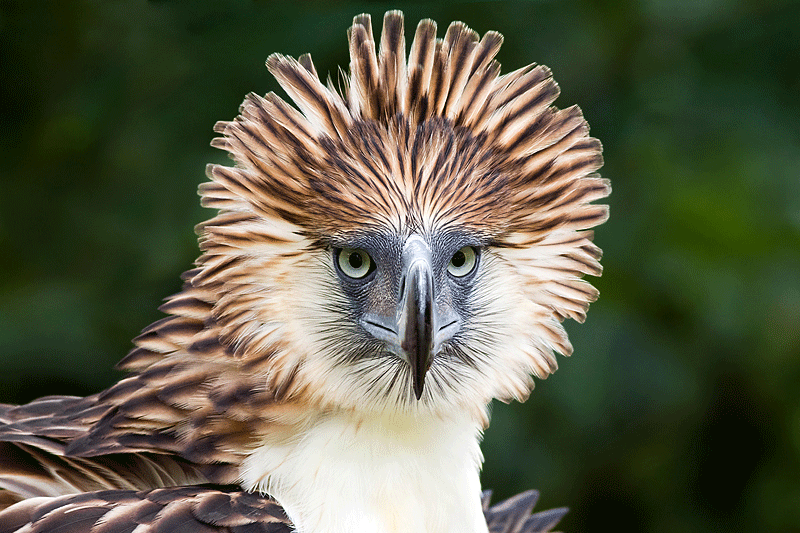
Philippine Eagle, Image copyright 2012: Alain Pascua. Before and after animated GIF.
|
The regal and powerful Philippine Eagle image featuring this majestic bird’s spectacular raised crest was runner-up in both voting categories. With some Photoshop work that would include background smoothing and bill clean-up (both allowed by the lenient competition rules) this image might have overtaken the toucan image for first place; unusually light areas of background will almost always draw the viewer’s attention away from the subject as the whitish circles did here…. For the background clean-up Denise Ippolito (thank you very much Lady D) used a reduced opacity Clone Stamp Tool, the Patch Tool, and an inverse layer mask and selectively ran Noise Reduction on only the background. I added a bit of bill clean-up to produce the “after” image in the animated GIF above. All as described in detail in Digital Basics.
|
|
|
Great Horned Owl on curved branch, Image copyright 2012: Eric A. Rosen.
|
This image–by a very small margin–did well better in the judges’ voting than in the pubic voting. I loved the rolling hills, the killer clouds, and those huge talons but especially the creativity that went into the design of the image. Selectively lightening the subject would have improved this one.
This very strong and sharp image with the killer wing position suffered only from the the dark above/light below background with the strong line of demarcation between the two. Images with dark above/light below motifs almost always have a strike against them as the light area dominates and draws the viewer’s eye. Fourth place with the judges and third place with the public represents another strong correlation in the voting, a clear indication that the cream has risen to the top in this category.
|
|
|
Bald Eagle screaming, Image copyright 2012: Paul Klenck. Canon 50D and tripod-mounted Canon 300/2.8 + 1.4x. f5 at 1/160, ISO 200.
|
.
.
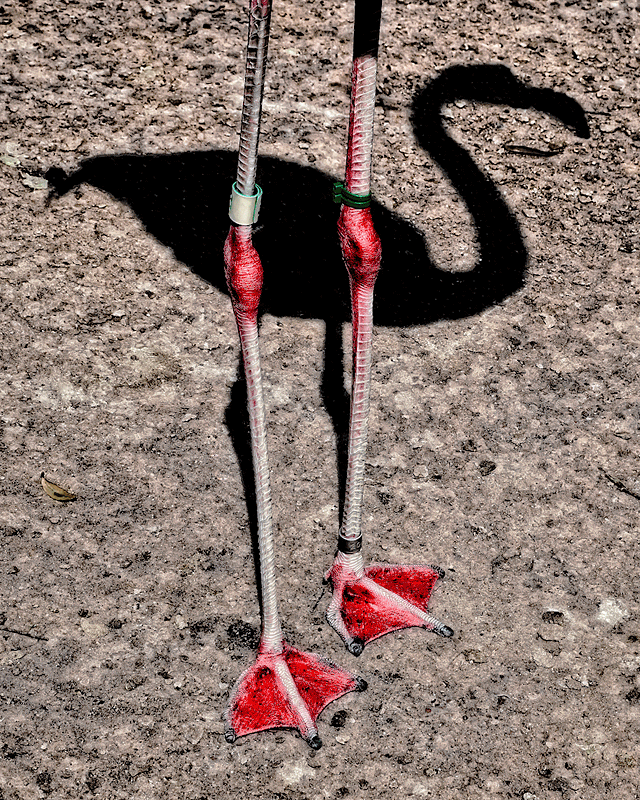
Flamingo legs with shadow before and after
|
The three images above finished in a tie for 5th place in the judge’s voting. “Bald Eagle screaming” (7th in the public vote) is a powerful image with a sweet background and a good head angle. Bringing up a bit more detail in the WHITEs on the top of the head would have improved it. This image and many Bald Eagle images in the contest seemed to suffer a bit of prejudice with the official judges perhaps because they have been seeing too many good photos of this species in recent year. “Flamingo head and neck” (5th in the public vote) is an elegant and beautifully designed zoo shot; the curve of the neck captivated everyone. “Flamingo legs with shadow” (9th in the public voting despite some ardent supporters) did the same by way of the wonderfully creative image design. Both Denise and I felt that it too could have been greatly improved within the rules. For the after image I cleaning and blackened the shadow, cleaned up the substrate, and reduced the contrast as seen in the animated GIF above. Clean-up and contrast adjustments as described in detail in Digital Basics.
“Barred Owl sleeping” placed 8th in the official voting and 10th in the public voting. Those sky blue eyelids make this peaceful a joy to behold. A bit darker overall with a bit more contrast would have improved this one.
.
|
|
|
Great Horned Owl vertical
|
The two images above tied for 9th in the judges’ standings. Many (including me) loved the colors and the soft tones in “Waterfowl sleeping” (a stronger 6th in the public voting). I am pretty sure that some of the judges felt as I did that this one was a bit tight in the frame and that the steep angle of declination to the subject detracted somewhat. “Great Horned Owl vertical” is a pretty much perfect image; I could not think of a single way to improve it. It is nicely framed, the light is sweet, the green background and the mossy perch are killer, the open bill is a plus, and those huge talons rock. It suffered only from the strong competition and, as with the screaming Bald Eagle, perhaps from a bit of judicial prejudice; this is a commonly photographed rehab species. On second thought, a bit more room all around would have yielded a more pleasing image.
Comments Welcome
Your comments on the images, on my analysis, or the voting are of course welcome. Again we ask those who had honored images to leave a comment letting us know their name, which image or images are theirs, the location, and the gear that they used.
B&H Double Rebates Include the 5D Mark III
Click here. Select one of four current Canon camera bodies–both the EOS-5D Mark III and the EOS-7D are in the group. Add a lens–there are 30 in the group, a Series III teleconverter, or a Speedlite, and enjoy large double rebates. The lenses include lots of my favorites: the 70-200mm f/4 L IS, the 70-200mm f/2.8L IS II, the circle lens, the 180 macro, and the 300mm f/4L IS. You can check the specs on all Canon telephoto lenses here. This double rebate offer expires on April 2, 2012.
Nikon Dslr + Lens Bundle Rebates
Click here for details. Offer includes the brand new D3200 and the D7000.
May 18th, 2012
|
|
|
Congratulations to Stan Hoyt. His image of a Toco Toucan is the frst prize winner in the Captive category of the BIRDS AS ART 1st International Bird Photography Competition.
|
Toco Toucan: Stan Hoyt
Stan’s toucan image was voted first by the contest judges in the Captive category receiving 23 out of a possible 25 points. It just edged out Alain Pascua’s fine Great Philippine Eagle image below that scored 21 out of the possible 25 points. Interestingly enough it was also the first choice in the public voting receiving a total of 444 points, just beating out Alain’s Philippine Eagle below which garnered 429 points. As just one of the five finals contest judges I can say that I like the bold colors, the sharpness, the black background, the unusual perspective, the image design, and that wicked eye highlight.
Here is the e-mail that we received from Stan:
Dear Artie, Peter, and Denise.
Wow! This is one email I never expected to receive. I am deeply honored that one of my photos is being considered. I have already uploaded the raw and the optimized images. Here is the information you requested.
Bird Species: Toco Toucan
Location: Alligator Farm, St. Augustine, FL
When: June 23, 2006 at 3:31 PM
Details: Canon 20D, 300mm f4 @f7.1, 1/640 sec., ISO 200, -1 1/3 exp. comp., evaluative metering, AI Servo AF, handheld
Having already enjoyed a morning of photography at the Alligator Farm in St. Augustine, Florida, I returned in mid-afternoon, intending to go straight to the rookery. I took only a few steps past the entrance when my attention was captured by a toco toucan in a large screened enclosure. This beautiful bird was quite active, taking an interest in its surroundings, including the people passing by. Stopping to admire, I began to experiment by taking hand-held images from different locations and angles. The jungle foliage in the enclosure softened the afternoon sun, but also created a lot of dapplied sunlight and shadow. My camera kept wanting to focus on the fine dark mesh of the screen rather than the bird, and I wondered whether any of the images I took would be usable. It wasn’t until I got home and reviewed them on my computer that I saw that not only were several images acceptably sharp but noted that the mesh had created a peculiar cross-hatched catchlight that set off the toucan’s bold eye.
|
|
|
Congratulations to Alain Pascua. His Great Philippine Eagle image was awarded second prize in the Captive category of the BIRDS AS ART 1st International Bird Photography Competition.
|
Great Philippine Eagle, Alain Pascua.
Alain’s eagle was voted second by the contest judges in the Captive category. It received 21 out of a possible 25 points. It placed second in the public vote as well scoring 429 points. As one of five Finals judges I can say that this majestic and regal species along with its raised crest caught my attention from the moment that I saw it. If you have any suggestions on how this image could have been improved within the rules of the contest please leave a comment.
Here is what we heard from Alain:
English Name: Great Philippine Eagle
Common Name: Haring Ibon (Filipino, meaning King Bird), Monkey-eating Eagle (former English name)
Scientific Name: Pithecophaga jefferyi
Conservation Status: Critically Endangered
Range: Endemic to the Philippines, restricted in Eastern Luzon, Samar, Leyte and Mindanao
Location: Philippine Eagle Center, Davao City, Mindanao, Philippines
Date Photographed: June 11, 2010
Equipment: Canon EOS 50D, Canon EF 400mm f/5.6L USM, Benro GH-1 Gimbal Head and Tripod
Settings: 1/160 sec, f/5.6, ISO 800, Evaluative Metering, Manual Exposure in Available Light
I photograph birds in the wild, in their natural habitat, but with the difficulty of finding the Great Philippine Eagle in the wild brought about by its dwindling population and the difficult terrains in a few areas where it could be sighted, I contented myself in photographing it in captivity. I have to overcome the obstructions of cages, iron bars and wires though, so I timed my visit to the Philippine Eagle Center in Davao City in Mindanao during the celebration of Philippine Eagle Week when one of the Great Philippine Eagles is usually brought out of the cage and displayed at a public area. My focus was to capture the image of a majestic, royal, kingly and proud Great Philippine Eagle lording over the depressions of captivity, and fittingly portraying its stature as national bird of the Philippines and the largest eagle in the world. I spent the whole day at the breeding center, patiently waited for visitors to come and for feeding time during which periods the eagle was most active with its lion mane-like head crest standing up for seconds. I clicked more than a thousand shots and packed up only when I was contented enough that one of my images have truly captured and given justice to this great bird. That was on June 11, 2010, the eve of the celebration of the Philippine’s 112th National Independence Day, a very fitting day to pay homage to Haring Ibon – the Lord of the Forest and the King of Birds.
|
|
|
Congrats to Eric A. Rosen. His Great Horned Owl on curved branch was awarded third place in the Captive category of the BIRDS AS ART 1st International Bird Photography Competition.
|
Eric A. Rosen, Great Horned Owl on curved branch
Eric’s owl image was voted third by the contest judges in the Captive category. In somewhat of a surprise to me it finished 8th in the public voting (but only 19 points out of fifth place). I love the curved branch, the puffy white clouds, the great look at those huge talons, Eric’s choice of perspective, and the use of flash to even out the exposure. Selectively lightening the subject would have yielded an even stronger image.
From Eric via e-mail:
I created this image of a captive, non-releasable Great Horned Owl using a handheld Nikon D300 with the Nikkor 18-200mm telephoto lens (hand held at 42mm) and some fill flash. I volunteer my services as a photographer for a non-profit organization that rehabilitates birds that have been hurt; some of the birds are injured so badly that they can never be released back into the wilderness. This photo was taken in February 2010 at a private ranch in Ojai, CA.
Congrats!
Congrats to all who placed images in the top ten in the Captive category. You can see all ten honored images here. 210 images made the next to last cut. Only ten went to the judges. Getting to the final round is quite an accomplishment. The seven photographers who survived to the final round of judging are invited to leave a comment and let us know about their honored image. Note that each of the top three images was created with a focal length of less than 400mm. And all were made locally, near the photographers home.
Prizes (see below) will be shipped once all the winners are announced as several folks had more than one top three images. Be sure to patronize our sponsors; without them, this contest would not exist. More educational stuff from the Contest coming soon.
| First Prize |
2nd Prize |
Third Prize |
Sponsor |
| $100 Gift Certificate |
$50 Gift Certificate |
$25 Gift Certificate |
B&H PHOTO VIDEO |
| choice of lens plate |
P-5 camera body plate |
Plamp |
Wimberley |
| 16 GB 450 X UDMA Compact Flash Card |
Sensor Scope |
Universal Memory Card Reader |
Delkin Devices |
| Level 3 Gift Subscription |
Level 2 Gift Subscription |
Level 1 Gift Subscription |
Nature Photographer Magazine |
| $30 Discount Certificate |
$25 Discount Certificate |
$20 Discount Certificate |
Canvas On Demand |
| Laptop Bag or Pixel Sunscreen |
Pixel Pocket Rocket |
AA Battery Holder |
Think Tank |
| $50 Gift Certificate |
$25 Gift Certificate |
$10 Gift Certificate |
Lens Coat |
| Canon/Nikon Lens Plate |
Canon/Nikon Camera Body Plate |
. |
4th Generation Design |
| . |
Better Beamer |
Better Beamer Replacement Fresnel |
Visual Echoes |
| TriKlear Kit |
TriKlear Kit |
TriKlear Kit |
Lens Pen |
| Giottos MH 1302-655 BallHead |
Double Bubble |
. |
HP Marketing |
| BreezeBrowser Pro/Downloader Pro Combo |
BreezeBrowser Pro |
Downloader Pro |
Breeze Systems |
| Sito HD Version Gold Web Site |
|
|
Sito HD |
.
B&H Double Rebates Include the 5D Mark III
Click here. Select one of four current Canon camera bodies–both the EOS-5D Mark III and the EOS-7D are in the group. Add a lens–there are 30 in the group, a Series III teleconverter, or a Speedlite, and enjoy large double rebates. The lenses include lots of my favorites: the 70-200mm f/4 L IS, the 70-200mm f/2.8L IS II, the circle lens, the 180 macro, and the 300mm f/4L IS. You can check the specs on all Canon telephoto lenses here. This double rebate offer expires on April 2, 2012.
Nikon Dslr + Lens Bundle Rebates
Click here for details. Offer includes the brand new D3200 and the D7000.
May 17th, 2012 Contest Concerns…
Calvin (no last name) posted the comment below at yesterday’s hugely popular “You be the Judge: Captive” blog post here. (Voting will be open till 8am eastern time on Friday, 5/18/12 so it is not too late to join the fun and see how you do compared to the judges.)
“Does anyone else think that the contest (would) have been much more fair if all 5 of the judges had an opportunity to judge all the images, instead of just the 10 images that were chosen by Arthur Morris and 2 other people?“
Here is my answer: Calvin, The contest might possibly have been a bit more fair had we sent all 5,500 images to our four professional judges. The problem is that they all would have quit immediately. They are busy folks who kindly agreed to help with the final judging. They each spent a total of between 1 1/2 and 3 hours of their valuable time to carefully consider the 10-20 images in each of the 11 categories. All major contests have initial rounds of judging by a small group of involved folks. The panel of big-name judges never get to see the vast majority of entered images. In short, your implied suggestion is both impractical and unworkable.
It took Peter Kes, Denise Ippolito, and me nearly three full 8-hour days of hard work to choose the images that went to the judges. As I wrote elsewhere, this process was an extremely difficult one. To be fair to the panel of judges, we decided to send no more than twenty images forward in each of the eleven categories. In some categories–including the Captive category–getting down to twenty or less was fairly easy. In the more popular categories like Portraits, Action, Flight, and Behavior, getting down to 20 was wrenchingly difficult. At times I felt like a very cruel America’s Got Talent judge. As we got close to 20, we compared the strengths and weaknesses of some of the images while others clearly merited being included in the final group. If even one of us liked an image for the finals, it was included. As we deleted and refined our choices, we would often say, “This is an excellent image. If it were to be awarded a prize, would you be proud of our choice?” If all of us answered “No,” that image would be eliminated.
You mentioned “10 images” but in fact 163 of the 5,500 entered images went to the judges. A quick analysis of the public voting would seem to indicate that the initial selection process worked extremely well as all but 1 of the 10 images have garnered at least a single first place vote while two of the images are run-away points leaders. It will be interesting to see how the public evaluation compares to the actual picks of the judges: 1st, 2nd, and 3rd….
Interestingly enough, Calvin did not enter the contest nor did he take the five minutes to judge the presented images….
Do take a moment to leave a comment and answer Calvin’s original question: “Does anyone else think that the contest would have been much more fair if all 5 of the judges had an opportunity to judge all the images, instead of just the 10 images that were chosen by Arthur Morris and 2 other people?”
Mette’s Comment
Mette (first name or last?) posted the following:
T(o)ucan 5
Flamingo 4
“(I) can’t mark the other photos because they are not up to my standards. I would love to (see) the the photos that didn’t make it if these did.“
Interestingly enough, Mette did not enter the contest. Quite obviously, the rest of the group does not agree with Mette’s assessment. Please take a moment to let Mette know what you think of her comment. As I do not want to influence your responses, I will be sharing my thoughts on her comment later on.
To Be Honest
To be honest, I seriously considered deleting both of the comments above. Each was up for moderation; they needed to be approved by me in order to be visible. Like it or not there is no freedom of speech on my blog.
I was reading an article in Sports Illustrated yesterday by SI Editor Terry McDonnell in which he quoted SI Senior Writer Micheal Farber: “”But shining a light is never a bad thing, no matter what is illuminated.” Instantly it became clear to me that I should share both Calvin’s and Mette’s comments with the group. So that is what I did.
Those who enjoy any type of sports would surely enjoy reading “In My Tribe”; you can access the entire article by clicking here. There is lots of outstanding writing in Sports Illustrated and the article ranks right up there with the best.
May 15th, 2012 You Be the Judge: Captive
The judging for the BIRDS AS ART 1st International Bird Photography Competition is complete. All of the judges including me were stunned by the quality of the images. We will be posting all of the images that were sent to the judges. Each of you will have a chance to judge the images. Please read the directions below carefully. Your votes will not determine the winning images but it will be fun to see how everyone’s votes compare to the votes of the judges.
Below are the ten images in the Captive category that were sent to the five judges: Darrell Gulin, Chris Van Rooyen, Julie Zickefoose, Tim Laman (who filled in for a honey-mooning Andy Rouse), and yours truly. Here is a big time thank you to Darrell, Chris, Julie, and Tim. And a big time thanks also to Peter Kes and Denise Ippolito for helping me choose the images that were sent to the judges. We worked very hard for nearly three full days to get from more than 5500 images down to the final 163.
The Captive category is for photographs of captive, zoo, pet, or rehab birds. Before you vote, please click on each image to view it at full size. Then pick your five favorites and vote them 5, 4, 3, 2, and 1 with 5 being your very favorite. Like this:
Bald Eagle calling: 5
Flamingo head and neck: 4
Philippine Eagle: 3
Toucan: 2
Flamingo legs with shadow: 1
The “Sample Vote” values above are for illustrative purposes only. Please put each of your five favorites on its own line by hitting “enter” after each one. You can make your life easier by cut and pasting the name of each image that you wish to vote for. No ties; please assign a single digit, 5, 4, 3, 2 or 1 to each of your five favorites.
If you wish to comment on any or all of the images that you voted for, please do so below your five voting lines; this will make tallying the votes easier. Votes cast by those who fail to follow the formatting directions will be relegated to the Trash Bin.
A tally of the public vote along with the actual winning images for each category will be announced approximately 48 hours after each posting.
|
|
|
Great Horned Owl on curved branch
|
|
|
|
Flamingo head and neck,Flamingo Gardens, Davie FL. Image copyright 2012: Patty Corapi. Canon 7D and the 100-400mm at 285mm. Settings were ISO 400, 1/1250 at f/5.6 with some fill flash. Thanks for the wonderful honor. And Artie – I thank you for all you have taught me over the years. Congrats to the other winners as well. Everyone did a wonderful job.
|
|
|
|
Flamingo legs with shadow
|
|
|
|
Great Horned Owl vertical
|
May 14th, 2012
|
|
|
This adult male Purple Martin was photographed at Bay City, Oregon with the tripod-mounted Canon 800mm f/5.L IS lens, the 1.4X III TC, and the Canon EOS-1D Mark IV. ISO 400. Evaluative metering at +2 1/3 stops as framed: 1/320 sec. at f/11 in Manual mode in early morning light on a clear day at 8:05am.
I pushed the exposure as far to the right as possible without getting any blinkies in the sky or on the post to ensure maximum detail in the dark glossy feathers.
Central sensor (by necessity) AI Servo/Rear Focus AF and re-compose. Click here if you missed the Rear Focus Tutorial. Click on the image for a larger, sharper version. (Some of the images posted here suffer from Word Press compression when viewed at the smaller size.)
|
Tualatin River Bird Festival
Thanks to the generosity of Canon USA/Explorers of Light who sponsored my visit I enjoyed a wonderful long weekend in Tigard, Oregon. BAA fan and new friend Doug Schurman picked me up at the Portland Airport early on Thursday evening. He drove us to Tillamook, OR so that we could scout for the Sunday morning in-the-field workshop. Morro Bay IPT veteran Don Nelson our guide and my host for the weekend met us at 6:30 am on Thursday. Our first and best stop was at a unique Purple Martin colony on the bay at Bay City, OR just north of Tillamook. We returned on Sunday morning by bus to the delight of the 15 participants.
All three of my programs were well-received and the audiences were large, warm, and attentive. Thanks to Norman Penner for inviting me and to Canon EoL’s Steve Inglima for approving the trip. Both Doug and Don treated me like royalty and their kindnesses were greatly appreciated. It is nice to feel like King for a Weekend every now and then.
|
|
|
This adult male Purple Martin on the same piling was photographed at Bay City, Oregon with the tripod-mounted Canon 800mm f/5.L IS lens, the 1.4X III TC, and the Canon EOS-1D Mark IV. ISO 400. Evaluative metering at +3 stops off the sky: 1/320 sec. at f/9 in Manual mode.
This image was created on Thursday at 7:54 am when a cloud briefly covered the sun.
Central sensor (by necessity) AI Servo/Rear Focus AF and re-compose. Click here if you missed the Rear Focus Tutorial. Click on the image for a larger version.
|
Which Do You Like Best?
Which of the two images above do you prefer, the first image made in early morning light or the second made in white sky conditions. Please let us know why.
|
|
|
This image of the colony was created with the Canon 24-105mm L IS lens hand held at 24mm and the EOS-1D Mark IV. ISO 200. Evaluative metering +1 2/3 stops: 1/250 sec. at f/11.
Central sensor (by necessity) AI Servo/Rear Focus AF and re-compose. Click here if you missed the Rear Focus Tutorial. Click on the image for a larger, sharper version.
|
Purple Martin Magic
The rather dilapidated colony at Bay City, OR was perfect for early morning photography as the pilings were right on sun angle and there were several fairly decent thin perches provided by the rotting pilings. In 28 years of bird photography I had never previously enjoyed photographing this species on halfway decent perches.
|
|
|
This yawning adult female Purple Martin was photographed at Bay City, Oregon with the tripod-mounted Canon 800mm f/5.L IS lens, the 1.4X III TC, and the Canon EOS-1D Mark IV. ISO 400. Evaluative metering at +2 stops as framed: 1/320 sec. at f/14 in Manual mode in early morning light on a clear day at 7:40am.
Central sensor (by necessity) AI Servo/Rear Focus AF and re-compose. Click here if you missed the Rear Focus Tutorial. Click on the image for a larger, sharper version. (Some of the images posted here suffer from Word Press compression when viewed at the smaller size.)
|
I loved the yawn and the erect posture of this female.
|
|
|
This pair of Purple Martins was photographed sitting atop there decrepit nest box with the tripod-mounted Canon 800mm f/5.L IS lens, the 1.4X III TC, and the Canon EOS-1D Mark IV. ISO 400. Evaluative metering at +1 1/3 stops as framed: 1/1000 sec. at f/8 in Manual mode in morning light on a clear day at 8:19am.
Central sensor (by necessity) AI Servo/Rear Focus AF and re-compose. Click here if you missed the Rear Focus Tutorial. Click on the image for a larger, sharper version. (Some of the images posted here suffer from Word Press compression when viewed at the smaller size.)
|
It can never hurt to make images of interesting situations rather than creating only images that feature single birds set against clean backgrounds. Though the nest boxes were in need of repair the birds loved them and Don told me that the colony produces lots of young each year.
B&H Double Rebates Include the 5D Mark III
Click here. Select one of four current Canon camera bodies–both the EOS-5D Mark III and the EOS-7D are in the group. Add a lens–there are 30 in the group, a Series III teleconverter, or a Speedlite, and enjoy large double rebates. The lenses include lots of my favorites: the 70-200mm f/4 L IS, the 70-200mm f/2.8L IS II, the circle lens, the 180 macro, and the 300mm f/4L IS. You can check the specs on all Canon telephoto lenses here. This double rebate offer expires on April 2, 2012.
Nikon Dslr + Lens Bundle Rebates
Click here for details. Offer includes the brand new D3200 and the D7000.
Shopper’s Guide.
Support both the Bulletins and the Blog by making all your B & H purchases here.
Below is a list of the gear talked about in this blog post. Thanks a stack to all who have used the Shopper’s Guide links to purchase their gear as a thank you for all the free information that we bring you on the Blog and in the Bulletins. Before you purchase anything be sure to check out the advice in our Shopper’s Guide.
Shopper’s Guide
Below is a list of the gear used to create the images in today’s post. Thanks a stack to all who have used the Shopper’s Guide links to purchase their gear as a thank you for all the free information that we bring you on the Blog and in the Bulletins. Before you purchase anything be sure to check out the advice in our Shopper’s Guide.
Canon 800mm f/5.6L IS lens. Right now this is my all time favorite super-telephoto lens.
Canon 24-105mm L IS lens. I never head into the field without this versatile B-roll lens in my X-trahand vest.
Canon EF 1.4X III TC. This new TC is designed to work best with the new Series II super-telephoto lenses.
Canon EOS-1D Mark IV professional digital camera body. The very best professional digital camera body that I have ever used.
And from the BAA On-line Store:
LensCoats. I have a LensCoat on each of my big lenses to protect them from nicks and thus increase their re-sales value. All my big lens LensCoat stuff is in Hardwood Snow pattern.
LegCoat Tripod Leg Covers. I have four tripods active and each has a Hardwood Snow LegCoat on it to help prevent further damage to my tender shoulders 🙂 And you will love them in mega-cold weather….
Gitzo GT3530LS Tripod. This one will last you a lifetime.
Mongoose M3.6 Tripod Head. Right now this is the best tripod head around for use with lenses that weigh less than 9 pounds. For heavier lenses, check out the Wimberley V2 head.
CR-80 Replacement Foot for Canon 800. When using the 800 on a Mongoose as I do, replacing the lens foot with this accessory lets the lens sit like a dog whether pointed up or down and prevents wind-blown spinning of your lens on breezy days by centering the lens directly over the tripod.
Double Bubble Level. You will find one in my camera’s hot shoe whenever I am not using flash.
The Lens Align Mark II. I use the Lens Align Mark II pretty much religiously to micro-adjust all of my gear an average of once a month and always before a major trip. Enjoy our free comprehensive tutorial here.
BreezeBrowser. I do not see how any digital photographer can exist without this program.
May 11th, 2012
|
|
|
This Japanese Red-crowned Crane image was created at Tsurui Itoh Sanctuary, Hokkaido, Japan with the tripod-mounted Canon 800mm f/5.6L IS lens and the EOS-1D Mark IV. ISO 400. Evaluative metering +1/3 stop: 1/1250 sec. at f/5.6.
Central sensor (expand left and right) AI Servo/Rear Focus AF and re-compose. Click here if you missed the Rear Focus Tutorial. Click on the image for a larger version.
|
Nature’s Best Image Quiz Revelations
The image above was very well received by many of the folks who commented and in fact, I did enter this image in the 2012 Nature’s Best Contest. Not sure if I entered it in Art in Nature or Birds. Good luck to me.
|
|
|
After seeing an Andy Rouse image of a Sally Lightfoot crab on black lava rock surrounded by a blurred wave (in his book, Concepts of Nature, I was determined to try something similar (and perhaps better) on my next Galapagos visit. This image was created with the tripod-mounted Canon 800mm f/5.6L IS lens and the EOS-1D Mark IV. ISO 50. Evaluative metering -2 stops off the crab on the black rock alone: 1/30 sec. at f/9. (I knew that I would need to underexpose quite a bit to avoid losing detail in the white water of the breaking waves; I needed to check the histogram a few times to get it right.)
For a greater appreciation of the image, click on the photo. Then click on the enlarged version to close it.
|
I could not enter the Sally Lightfoot image above in the 2012 Nature’s Best Contest because it was honored in the Art in Nature category of the 2011 contest. Those who suggested that I not enter it might wish to reconsider. 🙂
|
|
|
This Snow Goose/White-fronted Goose blur was created at Lower Klamath NWR, CA with the tripod-mounted Canon 800mm f/5.6L IS lens and the EOS-1D Mark IV. ISO 100. Evaluative metering +2 stops: 1/15 sec. at f/18.
Click on the image to see a larger version.
|
Few folks cared for the image above. I did in fact enter it in this years Nature’s Best Contest in the Art in Nature category. I hope that it does well. I love it. Many contest judges love blurs and so do I. For some they are an acquired taste.
|
|
|
This image–of a flock of Sanderlings with a single Dunlin and a single peep–was created at Cupsogue Beach, Long Island, NY with the tripod-mounted Canon 800mm f/5.6L IS lens and the EOS-1D Mark IV. ISO 400. Evaluative metering +1 2/3 stops: 1/1250 sec. at f/9.
45-point AI Servo AF. For a greater appreciation of the image, click on the photo. Can you spot the two odd-ball species?
|
I could not enter the image above in the 2012 Nature’s Best Contest because it was also honored in the Art in Nature category of the 2011 category. Those who suggested that I not enter it might wish to reconsider. 🙂 I like that they named the Art in Nature category after me….
My Main Point
My main point is that if you are going to enter a contest it is a good plan to take a close look at the winning and honored images from prior contests and try to figure out what the judges are looking for. Tastes change over the years. The BBC contest used to honor what I call straight bird and wildlife portraits. Those days are over; they are now looking for spectacular action and out of the box stuff–blurs, unusual perspectives, insane weather, and they like. Coming soon here: “You Be the Judge.” Each of you will have a chance to vote on the images in each category that went to the judges in the BIRDS AS ART 1st International Bird Photography Competition. I can tell you that the winning images are spectacular, right on a par with the best of BBC and Nature’s Best. I could not be prouder.
B&H Double Rebates Include the 5D Mark III
Click here. Select one of four current Canon camera bodies–both the EOS-5D Mark III and the EOS-7D are in the group. Add a lens–there are 30 in the group, a Series III teleconverter, or a Speedlite, and enjoy large double rebates. The lenses include lots of my favorites: the 70-200mm f/4 L IS, the 70-200mm f/2.8L IS II, the circle lens, the 180 macro, and the 300mm f/4L IS. You can check the specs on all Canon telephoto lenses here. This double rebate offer expires on April 2, 2012.
Nikon Dslr + Lens Bundle Rebates
Click here for details. Offer includes the brand new D3200 and the D7000.
Shopper’s Guide.
Support both the Bulletins and the Blog by making all your B & H purchases here.
Below is a list of the gear talked about in this blog post. Thanks a stack to all who have used the Shopper’s Guide links to purchase their gear as a thank you for all the free information that we bring you on the Blog and in the Bulletins. Before you purchase anything be sure to check out the advice in our Shopper’s Guide.
Canon 800mm f/5.6L IS lens. Right now this is my all time favorite super-telephoto lens.
Canon EOS-1D Mark IV professional digital camera body. The very best professional digital camera body that I have ever used.
And from the BAA On-line Store:
LensCoats. I have a LensCoat on each of my big lenses to protect them from nicks and thus increase their re-sales value. All my big lens LensCoat stuff is in Hardwood Snow pattern.
LegCoat Tripod Leg Covers. I have four tripods active and each has a Hardwood Snow LegCoat on it to help prevent further damage to my tender shoulders. 🙂 And you will love them in mega-cold weather….
GT3532 LS. This one replaces the GT3530LS Tripod and will last you a lifetime. I’ll be commenting on this new model soon. In short, I like it.
Mongoose M3.6 Tripod Head. Right now this is the best tripod head around for use with lenses that weigh less than 9 pounds. For heavier lenses, check out the Wimberley V2 head.
CR-80 Replacement Foot for Canon 800. When using the 800 on a Mongoose as I do, replacing the lens foot with this accessory lets the lens sit like a dog whether pointed up or down and prevents wind-blown spinning of your lens on breezy days by centering the lens directly over the tripod.
Double Bubble Level. You will find one in my camera’s hot shoe whenever I am not using flash.
The Lens Align Mark II. I use the Lens Align Mark II pretty much religiously to micro-adjust all of my gear an average of once a month and always before a major trip. Enjoy our free comprehensive tutorial here.
BreezeBrowser. I do not see how any digital photographer can exist without this program.
May 8th, 2012
|
|
|
This Japanese Red-crowned Crane image was created at Tsurui Itoh Sanctuary, Hokkaido, Japan with the tripod-mounted Canon 800mm f/5.6L IS lens and the EOS-1D Mark IV. ISO 400. Evaluative metering +1/3 stop: 1/1250 sec. at f/5.6.
Central sensor (expand left and right) AI Servo/Rear Focus AF and re-compose. Click here if you missed the Rear Focus Tutorial. Click on the image for a larger version.
|
Nature’s Best Image Quiz
Please let me know which if any of the four images presented here you would enter in the Nature’s Best Contest. And which you would not enter. And in either case, why. The deadline was yesterday, May 7. I completed two entries, 40 images in all. No spoilers please. 🙂
BTW, these are the categories: African Wildlife, Animal Antics, Art in Nature, Birds, Endangered Species, Landscape, Oceans, People in Nature, Plant Life, Power of Nature, Small World, Wildlife, Zoos and Aquariums. Learn more about the categories by scrolling down here.
|
|
|
After seeing an Andy Rouse image of a Sally Lightfoot crab on black lava rock surrounded by a blurred wave (in his book, Concepts of Nature, I was determined to try something similar (and perhaps better) on my next Galapagos visit. This image was created with the tripod-mounted Canon 800mm f/5.6L IS lens and the EOS-1D Mark IV. ISO 50. Evaluative metering -2 stops off the crab on the black rock alone: 1/30 sec. at f/9. (I knew that I would need to underexpose quite a bit to avoid losing detail in the white water of the breaking waves; I needed to check the histogram a few times to get it right.)
For a greater appreciation of the image, click on the photo. Then click on the enlarged version to close it.
|
Join me on the world’s best Galapagos Photo-Cruise/July 2-16, 20i3. Two full weeks +, world’s best guide and itinerary. Click here and scroll down for details.
|
|
|
This image was created at Lower Klamath NWR, CA with the tripod-mounted Canon 800mm f/5.6L IS lens and the EOS-1D Mark IV. ISO 100. Evaluative metering +2 stops: 1/15 sec. at f/18.
Click on the image to see a larger version.
|
I lucked out on my visit to Klamath last February; snow brought tens of thousands of light and dark geese to the refuge.
|
|
|
This image–of a flock of Sanderlings with a single Dunlin and a single peep–was created at Cupsogue Beach, Long Island, NY with the tripod-mounted Canon 800mm f/5.6L IS lens and the EOS-1D Mark IV. ISO 400. Evaluative metering +1 2/3 stops: 1/1250 sec. at f/9.
45-point AI Servo AF. For a greater appreciation of the image, click on the photo. Can you spot the two odd-ball species?
|
More luck here. Had it been a clear morning, I would have gone home empty-handed.
B&H Double Rebates Include the 5D Mark III
Click here. Select one of four current Canon camera bodies–both the EOS-5D Mark III and the EOS-7D are in the group. Add a lens–there are 30 in the group, a Series III teleconverter, or a Speedlite, and enjoy large double rebates. The lenses include lots of my favorites: the 70-200mm f/4 L IS, the 70-200mm f/2.8L IS II, the circle lens, the 180 macro, and the 300mm f/4L IS. You can check the specs on all Canon telephoto lenses here. This double rebate offer expires on April 2, 2012.
Nikon Dslr + Lens Bundle Rebates
Click here for details. Offer includes the brand new D3200 and the D7000.
Shopper’s Guide.
Support both the Bulletins and the Blog by making all your B & H purchases here.
Below is a list of the gear talked about in this blog post. Thanks a stack to all who have used the Shopper’s Guide links to purchase their gear as a thank you for all the free information that we bring you on the Blog and in the Bulletins. Before you purchase anything be sure to check out the advice in our Shopper’s Guide.
Canon 800mm f/5.6L IS lens. Right now this is my all time favorite super-telephoto lens.
Canon EOS-1D Mark IV professional digital camera body. The very best professional digital camera body that I have ever used.
And from the BAA On-line Store:
LensCoats. I have a LensCoat on each of my big lenses to protect them from nicks and thus increase their re-sales value. All my big lens LensCoat stuff is in Hardwood Snow pattern.
LegCoat Tripod Leg Covers. I have four tripods active and each has a Hardwood Snow LegCoat on it to help prevent further damage to my tender shoulders 🙂 And you will love them in mega-cold weather….
GT3532 LS. This one replaces the GT3530LS Tripod and will last you a lifetime. I’ll be commenting on this new model soon. In short, I like it.
Mongoose M3.6 Tripod Head. Right now this is the best tripod head around for use with lenses that weigh less than 9 pounds. For heavier lenses, check out the Wimberley V2 head.
CR-80 Replacement Foot for Canon 800. When using the 800 on a Mongoose as I do, replacing the lens foot with this accessory lets the lens sit like a dog whether pointed up or down and prevents wind-blown spinning of your lens on breezy days by centering the lens directly over the tripod.
Double Bubble Level. You will find one in my camera’s hot shoe whenever I am not using flash.
The Lens Align Mark II. I use the Lens Align Mark II pretty much religiously to micro-adjust all of my gear an average of once a month and always before a major trip. Enjoy our free comprehensive tutorial here.
BreezeBrowser. I do not see how any digital photographer can exist without this program.
|
|

